
Rational Planning Model
Evolution of different planning models
Different authors and scholars coined different planning theories which evolved over time. Planning theories are an attempt to refine the planning process so as to produce better plans. With more and more people working some of the well-known planning concepts like rational planning model, advocacy planning concept , collaborative planning theory , political economic model in urban planning , critical minimum efforts theory etc. emerged. Among these Rational Planning Model is considered to be most successful and even used today.
A brief history of Rational Planning Model
The rational planning model is the process of understanding a problem by establishing and evaluating planning criteria, formulation of alternatives and implementing them and finally monitoring the progress of the chosen alternatives. The rational planning model is central in the development of transport planning & modern planning. Similarly, rational decision-making model is a process of making decisions which are logically sound. This multi-step model and aims to be logical and follow the orderly path from problem identification through solution.

The RCM (Rational Comprehensive Model) for planning owes its origins to Enlightenment epistemology (Sandercock, 1998; Allmendinger, 2002), as it is centred on decisions and principles that are based on reason, logic and scientific facts with little or no emphasis on values and emotions. Due to its tendency towards scientific method and its decision-making process, Faludi has termed it ‘procedural planning theory’. He sees planning as a procedure and declares that “the planning theorist depends on first-hand experience, reflects upon it, and puts it into context” (Faludi, 1978:179). Therefore, the planner learns from experience and can define the correct method or procedure to follow to get the correct result. Meanwhile Sandercock (1998) refers to the rational comprehensive model as ‘technocratic planning’ due to its emphasis on technical expertise and skills and its steadfast belief that technology and social science can be used to solve our problems.
Related: Advocacy Planning Concept
Terms used in Rational Decision Model
- Goals – Goals are broad statements that we intend to achieve. They are quite general and abstract.
- Objectives – Objectives are more specific, measurable and clear as they help to progress towards the goals. They are the means to actually fulfil the goals.
- Targets – they are further specific and specify the time against which the actions need to be completed.
- Data – Data is raw, unorganized facts that need to be processed.
- Information – When data is processed, organized, structured or presented in a given context so as to make it useful, it is called Information.
- Model – A model is simply a schematic but precise description of the system using assumptions, which appears to fit its past behaviour and which can, therefore, be used, it is hoped, to predict the future
- Projections – Projections are usually carried out based on a number of alternative assumptions based on trends of growth and other linked factors like future policy of the government, attitude of people etc. They refer to the probable value of data in future.
- Estimate – Estimate refers to the past date. For example, suppose we wish to have population of India for 2009 today, which is not available, so we have to estimate it based on some previous available data of other years.
- Forecast – Forecast has an element of prediction into the near future using current data and sophisticated instruments. For instance, forecasting the weather in the next 24 hours.
Stages of Rational Planning Model
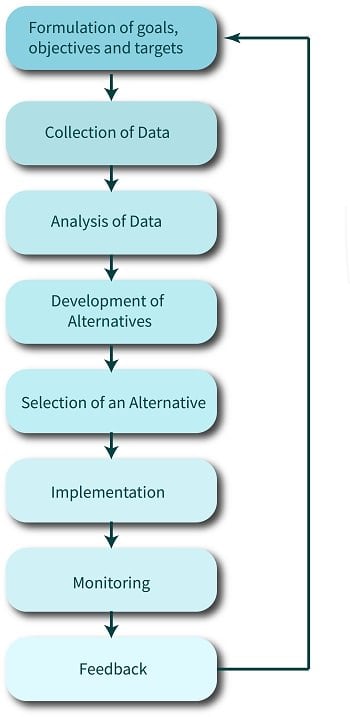
Related: Collaborative Planning Theory
Criticism of Rational Planning Model
Critique of the Rational Comprehensive Planning Model: The RCM of planning has been the subject of numerous criticisms. Michael Thomas (1982:14, in Paris, 1982) criticised the RCM’s focus on means rather than ends and claimed that the model is “essentially ‘contentless’ in that it specifies thinking and acting procedures but does not investigate what is the content of these” (Thomas, 1982, p.14, in Paris 1982). The model is accused of being abstract “offering merely an extended definition of planning and not saying anything about how planning in practice operated or what its effects were” (Taylor 1998:96). Advocate planners argued that what was portrayed as the ‘Public interest’ in the RCM represented merely the interests of the privileged. They maintain that no common social interest exists and that the RCM neglects the interests of both the poor and nature (Campbell and Fainstein 2003).
The comprehensiveness of the model has also come under question by such critics as Lindblom (2003 in Campbell and Fainstein 2003) and Altshuler (1965), who argue that due to limited time and resources available for making a decision and exploring all alternative options it is practically impossible to be thoroughly comprehensive (Taylor 1998; Campbell and Fainstein 2003). It also requires an exceptional level of knowledge, analysis and organisational coordination to absorb and make sense of all the relevant information; planners may end up being more confused and thus less rational (Campbell and Fainstein 2003; Taylor 1998). Forester (1999:46) argues that even if planners are “quite alone” in making a rational decision, they will still do so in anticipation of certain other people’s opinions whom “they know they must finally come to some form of agreement”, and so the decision is neither fully comprehensive or rational in this sense.
Sandercock (1998:88) points out that in this model “the planner is indisputably ‘The knower’, relying strictly on ‘his’ professional expertise and objectivity to do what is best for an undifferentiated public”. Sandercock also highlights the point that the RCM “privileges scientific and technical knowledge over an array of equally important alternatives – experiential, intuitive, local knowledges” (Sandercock 1998:5). Knowledge gained from these practical and analytical modes by definition exclude those without professional training. This knowledge is based on technical jargons and is preferred to knowledge gained through other practices such as talking, listening, seeing, contemplating, and sharing.
Adding to the above limitations, there are a lot of assumptions, requirements without which the rational decision model is a failure. Therefore, they all have to be considered. The model assumes that we have or should or can obtain adequate information, both in terms of quality, quantity and accuracy. This applies to the situation as well as the alternative technical situations. It further assumes that you have or should or can obtain substantive knowledge of the cause and effect relationships relevant to the evaluation of the alternatives. In other words, it assumes that you have a thorough knowledge of all the alternatives and the consequences of the alternatives chosen. It further assumes that you can rank the alternatives and choose the best of it. The following are the limitations for the Rational Decision Making Model:
- requires a great deal of time
- requires great deal of information
- assumes rational, measurable criteria are available and agreed upon
- assumes accurate, stable and complete knowledge of all the alternatives, preferences, goals and consequences
- assumes a rational, reasonable, non – political world
What makes Rational Planning Model successful?
Ration decision model is considered to be most practical and apt for the needs of the planning process. Its based on the scientific reasoning which takes into account the use of modern technology and increased data collection. The data collected helps in establishing the rationale and thus helps in making a claim. Another characteristic is the preparation of alternative and then choosing best among the alternatives. Moreover as the process completes the last step for the first time addressed the problem of rigidity. Planning processes is often criticized for being too rigid. The feedback and monitoring provides the much-needed flexibility in the whole process so that timely modifications can be made to the plan.
About The Author

- school Campus Bookshelves
- menu_book Bookshelves
- perm_media Learning Objects
- login Login
- how_to_reg Request Instructor Account
- hub Instructor Commons
Margin Size
- Download Page (PDF)
- Download Full Book (PDF)
- Periodic Table
- Physics Constants
- Scientific Calculator
- Reference & Cite
- Tools expand_more
- Readability
selected template will load here
This action is not available.

11.2: Understanding Decision Making
- Last updated
- Save as PDF
- Page ID 34537

\( \newcommand{\vecs}[1]{\overset { \scriptstyle \rightharpoonup} {\mathbf{#1}} } \)
\( \newcommand{\vecd}[1]{\overset{-\!-\!\rightharpoonup}{\vphantom{a}\smash {#1}}} \)
\( \newcommand{\id}{\mathrm{id}}\) \( \newcommand{\Span}{\mathrm{span}}\)
( \newcommand{\kernel}{\mathrm{null}\,}\) \( \newcommand{\range}{\mathrm{range}\,}\)
\( \newcommand{\RealPart}{\mathrm{Re}}\) \( \newcommand{\ImaginaryPart}{\mathrm{Im}}\)
\( \newcommand{\Argument}{\mathrm{Arg}}\) \( \newcommand{\norm}[1]{\| #1 \|}\)
\( \newcommand{\inner}[2]{\langle #1, #2 \rangle}\)
\( \newcommand{\Span}{\mathrm{span}}\)
\( \newcommand{\id}{\mathrm{id}}\)
\( \newcommand{\kernel}{\mathrm{null}\,}\)
\( \newcommand{\range}{\mathrm{range}\,}\)
\( \newcommand{\RealPart}{\mathrm{Re}}\)
\( \newcommand{\ImaginaryPart}{\mathrm{Im}}\)
\( \newcommand{\Argument}{\mathrm{Arg}}\)
\( \newcommand{\norm}[1]{\| #1 \|}\)
\( \newcommand{\Span}{\mathrm{span}}\) \( \newcommand{\AA}{\unicode[.8,0]{x212B}}\)
\( \newcommand{\vectorA}[1]{\vec{#1}} % arrow\)
\( \newcommand{\vectorAt}[1]{\vec{\text{#1}}} % arrow\)
\( \newcommand{\vectorB}[1]{\overset { \scriptstyle \rightharpoonup} {\mathbf{#1}} } \)
\( \newcommand{\vectorC}[1]{\textbf{#1}} \)
\( \newcommand{\vectorD}[1]{\overrightarrow{#1}} \)
\( \newcommand{\vectorDt}[1]{\overrightarrow{\text{#1}}} \)
\( \newcommand{\vectE}[1]{\overset{-\!-\!\rightharpoonup}{\vphantom{a}\smash{\mathbf {#1}}}} \)
Learning Objectives
- Define decision making.
- Understand different types of decisions.
Decision making refers to making choices among alternative courses of action—which may also include inaction. While it can be argued that management is decision making, half of the decisions made by managers within organizations ultimately fail (Ireland & Miller, 2004; Nutt, 2002; Nutt, 1999). Therefore, increasing effectiveness in decision making is an important part of maximizing your effectiveness at work. This chapter will help you understand how to make decisions alone or in a group while avoiding common decision-making pitfalls.
Individuals throughout organizations use the information they gather to make a wide range of decisions. These decisions may affect the lives of others and change the course of an organization. For example, the decisions made by executives and consulting firms for Enron ultimately resulted in a $60 billion loss for investors, thousands of employees without jobs, and the loss of all employee retirement funds. But Sherron Watkins, a former Enron employee and now-famous whistleblower, uncovered the accounting problems and tried to enact change. Similarly, the decision made by firms to trade in mortgage-backed securities is having negative consequences for the entire economy in the United States. All parties involved in such outcomes made a decision, and everyone is now living with the consequences of those decisions.
Types of Decisions
Most discussions of decision making assume that only senior executives make decisions or that only senior executives’ decisions matter. This is a dangerous mistake.
Peter Drucker
Despite the far-reaching nature of the decisions in the previous example, not all decisions have major consequences or even require a lot of thought. For example, before you come to class, you make simple and habitual decisions such as what to wear, what to eat, and which route to take as you go to and from home and school. You probably do not spend much time on these mundane decisions. These types of straightforward decisions are termed programmed decisions , or decisions that occur frequently enough that we develop an automated response to them. The automated response we use to make these decisions is called the decision rule . For example, many restaurants face customer complaints as a routine part of doing business. Because complaints are a recurring problem, responding to them may become a programmed decision. The restaurant might enact a policy stating that every time they receive a valid customer complaint, the customer should receive a free dessert, which represents a decision rule.

On the other hand, unique and important decisions require conscious thinking, information gathering, and careful consideration of alternatives. These are called nonprogrammed decisions . For example, in 2005 McDonald’s Corporation became aware of the need to respond to growing customer concerns regarding the unhealthy aspects (high in fat and calories) of the food they sell. This is a nonprogrammed decision, because for several decades, customers of fast-food restaurants were more concerned with the taste and price of the food, rather than its healthiness. In response to this problem, McDonald’s decided to offer healthier alternatives such as the choice to substitute French fries in Happy Meals with apple slices and in 2007 they banned the use of trans fat at their restaurants.
A crisis situation also constitutes a nonprogrammed decision for companies. For example, the leadership of Nutrorim was facing a tough decision. They had recently introduced a new product, ChargeUp with Lipitrene, an improved version of their popular sports drink powder, ChargeUp. At some point, a phone call came from a state health department to inform them of 11 cases of gastrointestinal distress that might be related to their product, which led to a decision to recall ChargeUp. The decision was made without an investigation of the information. While this decision was conservative, it was made without a process that weighed the information. Two weeks later it became clear that the reported health problems were unrelated to Nutrorim’s product. In fact, all the cases were traced back to a contaminated health club juice bar. However, the damage to the brand and to the balance sheets was already done. This unfortunate decision caused Nutrorim to rethink the way decisions were made when under pressure. The company now gathers information to make informed choices even when time is of the essence (Garvin, 2006).
Decisions can be classified into three categories based on the level at which they occur. Strategic decisions set the course of an organization. Tactical decisions are decisions about how things will get done. Finally, operational decisions refer to decisions that employees make each day to make the organization run. For example, think about the restaurant that routinely offers a free dessert when a customer complaint is received. The owner of the restaurant made a strategic decision to have great customer service. The manager of the restaurant implemented the free dessert policy as a way to handle customer complaints, which is a tactical decision. Finally, the servers at the restaurant are making individual decisions each day by evaluating whether each customer complaint received is legitimate and warrants a free dessert.
Figure 11.4 Examples of Decisions Commonly Made Within Organizations
In this chapter we are going to discuss different decision-making models designed to understand and evaluate the effectiveness of nonprogrammed decisions. We will cover four decision-making approaches, starting with the rational decision-making model, moving to the bounded rationality decision-making model, the intuitive decision-making model, and ending with the creative decision-making model.
Making Rational Decisions
The rational decision-making model describes a series of steps that decision makers should consider if their goal is to maximize the quality of their outcomes. In other words, if you want to make sure that you make the best choice, going through the formal steps of the rational decision-making model may make sense.
Let’s imagine that your old, clunky car has broken down, and you have enough money saved for a substantial down payment on a new car. It will be the first major purchase of your life, and you want to make the right choice. The first step, therefore, has already been completed—we know that you want to buy a new car. Next, in step 2, you’ll need to decide which factors are important to you. How many passengers do you want to accommodate? How important is fuel economy to you? Is safety a major concern? You only have a certain amount of money saved, and you don’t want to take on too much debt, so price range is an important factor as well. If you know you want to have room for at least five adults, get at least 20 miles per gallon, drive a car with a strong safety rating, not spend more than $22,000 on the purchase, and like how it looks, you have identified the decision criteria . All the potential options for purchasing your car will be evaluated against these criteria. Before we can move too much further, you need to decide how important each factor is to your decision in step 3. If each is equally important, then there is no need to weigh them, but if you know that price and mpg are key factors, you might weigh them heavily and keep the other criteria with medium importance. Step 4 requires you to generate all alternatives about your options. Then, in step 5, you need to use this information to evaluate each alternative against the criteria you have established. You choose the best alternative (step 6), and then you would go out and buy your new car (step 7).
Of course, the outcome of this decision will influence the next decision made. That is where step 8 comes in. For example, if you purchase a car and have nothing but problems with it, you will be less likely to consider the same make and model when purchasing a car the next time.

While decision makers can get off track during any of these steps, research shows that searching for alternatives in the fourth step can be the most challenging and often leads to failure. In fact, one researcher found that no alternative generation occurred in 85% of the decisions he studied (Nutt, 1994). Conversely, successful managers know what they want at the outset of the decision-making process, set objectives for others to respond to, carry out an unrestricted search for solutions, get key people to participate, and avoid using their power to push their perspective (Nutt, 1998).
The rational decision-making model has important lessons for decision makers. First, when making a decision, you may want to make sure that you establish your decision criteria before you search for alternatives. This would prevent you from liking one option too much and setting your criteria accordingly. For example, let’s say you started browsing cars online before you generated your decision criteria. You may come across a car that you feel reflects your sense of style and you develop an emotional bond with the car. Then, because of your love for the particular car, you may say to yourself that the fuel economy of the car and the innovative braking system are the most important criteria. After purchasing it, you may realize that the car is too small for your friends to ride in the back seat, which was something you should have thought about. Setting criteria before you search for alternatives may prevent you from making such mistakes. Another advantage of the rational model is that it urges decision makers to generate all alternatives instead of only a few. By generating a large number of alternatives that cover a wide range of possibilities, you are unlikely to make a more effective decision that does not require sacrificing one criterion for the sake of another.
Despite all its benefits, you may have noticed that this decision-making model involves a number of unrealistic assumptions as well. It assumes that people completely understand the decision to be made, that they know all their available choices, that they have no perceptual biases, and that they want to make optimal decisions. Nobel Prize winning economist Herbert Simon observed that while the rational decision-making model may be a helpful device in aiding decision makers when working through problems, it doesn’t represent how decisions are frequently made within organizations. In fact, Simon argued that it didn’t even come close.
Think about how you make important decisions in your life. It is likely that you rarely sit down and complete all 8 of the steps in the rational decision-making model. For example, this model proposed that we should search for all possible alternatives before making a decision, but that process is time consuming, and individuals are often under time pressure to make decisions. Moreover, even if we had access to all the information that was available, it could be challenging to compare the pros and cons of each alternative and rank them according to our preferences. Anyone who has recently purchased a new laptop computer or cell phone can attest to the challenge of sorting through the different strengths and limitations of each brand and model and arriving at the solution that best meets particular needs. In fact, the availability of too much information can lead to analysis paralysis , in which more and more time is spent on gathering information and thinking about it, but no decisions actually get made. A senior executive at Hewlett-Packard Development Company LP admits that his company suffered from this spiral of analyzing things for too long to the point where data gathering led to “not making decisions, instead of us making decisions” (Zell, Glassman, & Duron, 2007). Moreover, you may not always be interested in reaching an optimal decision. For example, if you are looking to purchase a house, you may be willing and able to invest a great deal of time and energy to find your dream house, but if you are only looking for an apartment to rent for the academic year, you may be willing to take the first one that meets your criteria of being clean, close to campus, and within your price range.
Making “Good Enough” Decisions
The bounded rationality model of decision making recognizes the limitations of our decision-making processes. According to this model, individuals knowingly limit their options to a manageable set and choose the first acceptable alternative without conducting an exhaustive search for alternatives. An important part of the bounded rationality approach is the tendency to satisfice (a term coined by Herbert Simon from satisfy and suffice ), which refers to accepting the first alternative that meets your minimum criteria. For example, many college graduates do not conduct a national or international search for potential job openings. Instead, they focus their search on a limited geographic area, and they tend to accept the first offer in their chosen area, even if it may not be the ideal job situation. Satisficing is similar to rational decision making. The main difference is that rather than choosing the best option and maximizing the potential outcome, the decision maker saves cognitive time and effort by accepting the first alternative that meets the minimum threshold.
Making Intuitive Decisions
The intuitive decision-making model has emerged as an alternative to other decision making processes. This model refers to arriving at decisions without conscious reasoning. A total of 89% of managers surveyed admitted to using intuition to make decisions at least sometimes and 59% said they used intuition often (Burke & Miller, 1999). Managers make decisions under challenging circumstances, including time pressures, constraints, a great deal of uncertainty, changing conditions, and highly visible and high-stakes outcomes. Thus, it makes sense that they would not have the time to use the rational decision-making model. Yet when CEOs, financial analysts, and health care workers are asked about the critical decisions they make, seldom do they attribute success to luck. To an outside observer, it may seem like they are making guesses as to the course of action to take, but it turns out that experts systematically make decisions using a different model than was earlier suspected. Research on life-or-death decisions made by fire chiefs, pilots, and nurses finds that experts do not choose among a list of well thought out alternatives. They don’t decide between two or three options and choose the best one. Instead, they consider only one option at a time. The intuitive decision-making model argues that in a given situation, experts making decisions scan the environment for cues to recognize patterns (Breen, 2000; Klein, 2003; Salas & Klein, 2001). Once a pattern is recognized, they can play a potential course of action through to its outcome based on their prior experience. Thanks to training, experience, and knowledge, these decision makers have an idea of how well a given solution may work. If they run through the mental model and find that the solution will not work, they alter the solution before setting it into action. If it still is not deemed a workable solution, it is discarded as an option, and a new idea is tested until a workable solution is found. Once a viable course of action is identified, the decision maker puts the solution into motion. The key point is that only one choice is considered at a time. Novices are not able to make effective decisions this way, because they do not have enough prior experience to draw upon.
Making Creative Decisions
In addition to the rational decision making, bounded rationality, and intuitive decision-making models, creative decision making is a vital part of being an effective decision maker. Creativity is the generation of new, imaginative ideas. With the flattening of organizations and intense competition among companies, individuals and organizations are driven to be creative in decisions ranging from cutting costs to generating new ways of doing business. Please note that, while creativity is the first step in the innovation process, creativity and innovation are not the same thing. Innovation begins with creative ideas, but it also involves realistic planning and follow-through. Innovations such as 3M’s Clearview Window Tinting grow out of a creative decision-making process about what may or may not work to solve real-world problems.
The five steps to creative decision making are similar to the previous decision-making models in some keys ways. All the models include problem identification, which is the step in which the need for problem solving becomes apparent. If you do not recognize that you have a problem, it is impossible to solve it. Immersion is the step in which the decision maker consciously thinks about the problem and gathers information. A key to success in creative decision making is having or acquiring expertise in the area being studied. Then, incubation occurs. During incubation, the individual sets the problem aside and does not think about it for a while. At this time, the brain is actually working on the problem unconsciously. Then comes illumination, or the insight moment when the solution to the problem becomes apparent to the person, sometimes when it is least expected. This sudden insight is the “eureka” moment, similar to what happened to the ancient Greek inventor Archimedes, who found a solution to the problem he was working on while taking a bath. Finally, the verification and application stage happens when the decision maker consciously verifies the feasibility of the solution and implements the decision.

A NASA scientist describes his decision-making process leading to a creative outcome as follows: He had been trying to figure out a better way to de-ice planes to make the process faster and safer. After recognizing the problem, he immersed himself in the literature to understand all the options, and he worked on the problem for months trying to figure out a solution. It was not until he was sitting outside a McDonald’s restaurant with his grandchildren that it dawned on him. The golden arches of the M of the McDonald’s logo inspired his solution—he would design the de-icer as a series of Ms. [1] This represented the illumination stage. After he tested and verified his creative solution, he was done with that problem, except to reflect on the outcome and process.
How Do You Know If Your Decision-Making Process Is Creative?
Researchers focus on three factors to evaluate the level of creativity in the decision-making process. Fluency refers to the number of ideas a person is able to generate. Flexibility refers to how different the ideas are from one another. If you are able to generate several distinct solutions to a problem, your decision-making process is high on flexibility. Originality refers to how unique a person’s ideas are. You might say that Reed Hastings, founder and CEO of Netflix Inc. is a pretty creative person. His decision-making process shows at least two elements of creativity. We do not know exactly how many ideas he had over the course of his career, but his ideas are fairly different from each other. After teaching math in Africa with the Peace Corps, Hastings was accepted at Stanford, where he earned a master’s degree in computer science. Soon after starting work at a software company, he invented a successful debugging tool, which led to his founding of the computer troubleshooting company Pure Software LLC in 1991. After a merger and the subsequent sale of the resulting company in 1997, Hastings founded Netflix, which revolutionized the DVD rental business with online rentals delivered through the mail with no late fees. In 2007, Hastings was elected to Microsoft’s board of directors. As you can see, his ideas are high in originality and flexibility (Conlin, 2007).
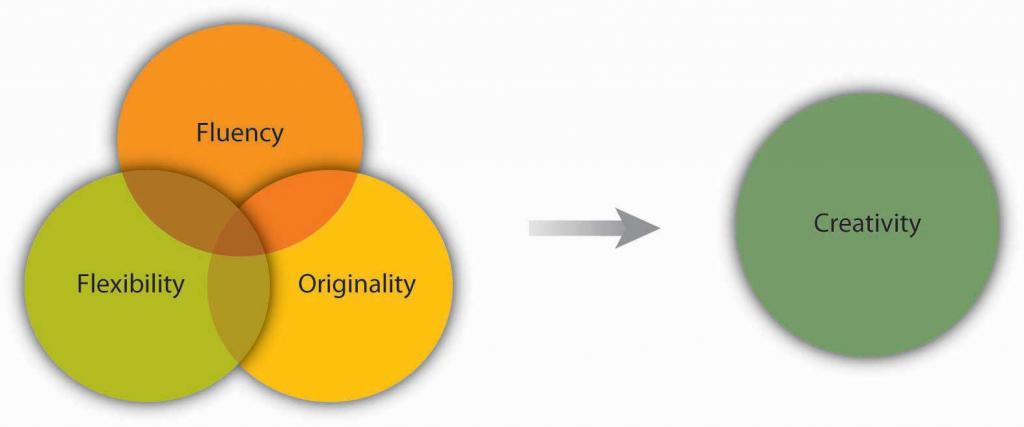
Some experts have proposed that creativity occurs as an interaction among three factors: people’s personality traits (openness to experience, risk taking), their attributes (expertise, imagination, motivation), and the situational context (encouragement from others, time pressure, physical structures) (Amabile, 1988; Amabile et al., 1996; Ford & Gioia, 2000; Tierney, Farmer, & Graen, 1999; Woodman, Sawyer, & Griffin, 1993). For example, research shows that individuals who are open to experience, less conscientious, more self-accepting, and more impulsive tend to be more creative (Feist, 1998).
OB Toolbox: Ideas for Enhancing Organizational Creativity
- Diversify your team to give them more inputs to build on and more opportunities to create functional conflict while avoiding personal conflict.
- Change group membership to stimulate new ideas and new interaction patterns.
- Leaderless teams can allow teams freedom to create without trying to please anyone up front.
- Engage in brainstorming to generate ideas. Remember to set a high goal for the number of ideas the group should come up with, encourage wild ideas, and take brainwriting breaks.
- Use the nominal group technique (see Tools and Techniques for Making Better Decisions below) in person or electronically to avoid some common group process pitfalls. Consider anonymous feedback as well.
- Use analogies to envision problems and solutions.
- Challenge teams so that they are engaged but not overwhelmed.
- Let people decide how to achieve goals , rather than telling them what goals to achieve.
- Support and celebrate creativity even when it leads to a mistake. Be sure to set up processes to learn from mistakes as well.
- Role model creative behavior.
- Institute organizational memory so that individuals do not spend time on routine tasks.
- Build a physical space conducive to creativity that is playful and humorous—this is a place where ideas can thrive.
- Incorporate creative behavior into the performance appraisal process.
Sources: Adapted from ideas in Amabile, T. M. (1998). How to kill creativity. Harvard Business Review , 76 , 76–87; Gundry, L. K., Kickul, J. R., & Prather, C. W. (1994). Building the creative organization. Organizational Dynamics , 22 , 22–37; Keith, N., & Frese, M. (2008). Effectiveness of error management training: A meta-analysis. Journal of Applied Psychology , 93 , 59–69. Pearsall, M. J., Ellis, A. P. J., & Evans, J. M. (2008). Unlocking the effects of gender faultlines on team creativity: Is activation the key? Journal of Applied Psychology , 93 , 225–234. Thompson, L. (2003). Improving the creativity of organizational work groups. Academy of Management Executive , 17 , 96–109.
There are many techniques available that enhance and improve creativity. Linus Pauling, the Nobel Prize winner who popularized the idea that vitamin C could help strengthen the immune system, said, “The best way to have a good idea is to have a lot of ideas.” [2] One popular method of generating ideas is to use brainstorming. Brainstorming is a group process of generating ideas that follow a set of guidelines, including no criticism of ideas during the brainstorming process, the idea that no suggestion is too crazy, and building on other ideas (piggybacking). Research shows that the quantity of ideas actually leads to better idea quality in the end, so setting high idea quotas , in which the group must reach a set number of ideas before they are done, is recommended to avoid process loss and maximize the effectiveness of brainstorming. Another unique aspect of brainstorming is that since the variety of backgrounds and approaches give the group more to draw upon, the more people are included in the process, the better the decision outcome will be. A variation of brainstorming is wildstorming , in which the group focuses on ideas that are impossible and then imagines what would need to happen to make them possible (Scott, Leritz, & Mumford, 2004).
Figure 11.8
Which decision-making model should I use?
Key Takeaways
Decision making is choosing among alternative courses of action, including inaction. There are different types of decisions ranging from automatic, programmed decisions to more intensive nonprogrammed decisions. Structured decision-making processes include rational, bounded rationality, intuitive, and creative decision making. Each of these can be useful, depending on the circumstances and the problem that needs to be solved.
- What do you see as the main difference between a successful and an unsuccessful decision? How much does luck versus skill have to do with it? How much time needs to pass to know if a decision is successful or not?
- Research has shown that over half of the decisions made within organizations fail. Does this surprise you? Why or why not?
- Have you used the rational decision-making model to make a decision? What was the context? How well did the model work?
- Share an example of a decision in which you used satisficing. Were you happy with the outcome? Why or why not? When would you be most likely to engage in satisficing?
- Do you think intuition is respected as a decision-making style? Do you think it should be? Why or why not?
Amabile, T. M. (1988). A model of creativity and innovation in organizations. In B. M. Staw & L. L. Cummings (Eds.), Research in organizational behavior, vol. 10 (pp. 123–167) Greenwich, CT: JAI Press.
Amabile, T. M., Conti, R., Coon, H., Lazenby, J., & Herron, M. (1996). Assessing the work environment for creativity. Academy of Management Journal , 39 , 1154–1184.
Breen, B. (2000, August). What’s your intuition? Fast Company , 290.
Burke, L. A., & Miller, M. K. (1999). Taking the mystery out of intuitive decision making. Academy of Management Executive , 13 , 91–98.
Conlin, M. (2007, September 14). Netflix: Recruiting and retaining the best talent. Business Week Online . Retrieved March 1, 2008, from http://www.businessweek.com/managing/content/sep2007/ca20070913_564868.htm?campaign_id=rss_null .
Feist, G. J. (1998). A meta-analysis of personality in scientific and artistic creativity. Personality and Social Psychology Review , 2 , 290–309.
Ford, C. M., & Gioia, D. A. (2000). Factors influencing creativity in the domain of managerial decision making. Journal of Management , 26 , 705–732.
Garvin, D. A. (2006, January). All the wrong moves. Harvard Business Review , 84 , 18–23.
Ireland, R. D., & Miller, C. C. (2004). Decision making and firm success. Academy of Management Executive , 18 , 8–12.
Klein, G. (2003). Intuition at work . New York: Doubleday.
Nutt, P. C. (1994). Types of organizational decision processes. Administrative Science Quarterly , 29 , 414–550.
Nutt, P. C. (1998). Surprising but true: Half the decisions in organizations fail. Academy of Management Executive , 13 , 75–90.
Nutt, P. C. (1999). Surprising but true: Half the decisions in organizations fail. Academy of Management Executive , 13 , 75–90.
Nutt, P. C. (2002). Why decisions fail . San Francisco: Berrett-Koehler.
Salas, E., & Klein, G. (2001). Linking expertise and naturalistic decision making . Mahwah, NJ: Lawrence Erlbaum Associates.
Scott, G., Leritz, L. E., & Mumford, M. D. (2004). The effectiveness of creativity training: A quantitative review. Creativity Research Journal , 16 , 361–388.
Tierney, P., Farmer, S. M., & Graen, G. B. (1999). An examination of leadership and employee creativity: The relevance of traits and relationships. Personnel Psychology , 52 , 591–620.
Woodman, R. W., Sawyer, J. E., & Griffin, R. W. (1993). Toward a theory of organizational creativity. Academy of Management Review , 18 , 293–321.
Zell, D. M., Glassman, A. M., & Duron, S. A. (2007). Strategic management in turbulent times: The short and glorious history of accelerated decision making at Hewlett-Packard. Organizational Dynamics , 36 , 93–104.
- In person interview conducted by author at Ames Research Center, Mountain View, CA, 1990. ↵
- Quote retrieved May 1, 2008, from http://www.whatquote.com/quotes/linus-pauling/250801-the-best-way-to-have.htm . ↵

Want to create or adapt books like this? Learn more about how Pressbooks supports open publishing practices.
11.3 Understanding Decision Making
Learning objectives.
- Define decision making.
- Understand different types of decisions.
What Is Decision Making?
Decision making refers to making choices among alternative courses of action—which may also include inaction. While it can be argued that management is decision making, half of the decisions made by managers within organizations fail (Ireland & Miller, 2004; Nutt, 2002; Nutt, 1999). Therefore, increasing effectiveness in decision making is an important part of maximizing your effectiveness at work. This chapter will help you understand how to make decisions alone or in a group while avoiding common decision-making traps.
Individuals throughout organizations use the information they gather to make a wide range of decisions. These decisions may affect the lives of others and change the course of an organization. For example, the decisions made by executives and consulting firms for Enron ultimately resulted in a $60 billion loss for investors, thousands of employees without jobs, and the loss of all employee retirement funds. But Sherron Watkins, a former Enron employee and now-famous whistleblower, uncovered the accounting problems and tried to enact change. Similarly, the decisions made by firms to trade in mortgage-backed securities is having negative consequences for the entire U.S. economy. Each of these people made a decision, and each person, as well as others, is now living with the consequences of his or her decisions.
Because many decisions involve an ethical component, one of the most important considerations in management is whether the decisions you are making as an employee or manager are ethical. Here are some basic questions you can ask yourself to assess the ethics of a decision (Blanchard & Peale, 1988).
- Is this decision fair?
- Will I feel better or worse about myself after I make this decision?
- Does this decision break any organizational rules?
- Does this decision break any laws?
- How would I feel if this decision was broadcast on the news?
Types of Decisions
Despite the far-reaching nature of the decisions in the previous example, not all decisions have major consequences or even require a lot of thought. For example, before you come to class, you make simple and habitual decisions such as what to wear, what to eat, and which route to take as you go to and from home and school. You probably do not spend much time on these mundane decisions. These types of straightforward decisions are termed programmed decisions; these are decisions that occur frequently enough that we develop an automated response to them. The automated response we use to make these decisions is called the decision rule . For example, many restaurants face customer complaints as a routine part of doing business. Because this is a recurring problem for restaurants, it may be regarded as a programmed decision. To deal with this problem, the restaurant might have a policy stating that every time they receive a valid customer complaint, the customer should receive a free dessert, which represents a decision rule. Making strategic, tactical, and operational decisions is an integral part of the planning function in the P-O-L-C (planning-organizing-leading-controlling) model.
However, decisions that are unique and important require conscious thinking, information gathering, and careful consideration of alternatives. These are called nonprogrammed decisions . For example, in 2005, McDonald’s became aware of a need to respond to growing customer concerns regarding foods high in fat and calories. This is a nonprogrammed decision because for several decades, customers of fast-food restaurants were more concerned with the taste and price of the food, rather than the healthiness. In response, McDonald’s decided to offer healthier alternatives, such as substituting apple slices in Happy Meals for French fries and discontinuing the use of trans fats. A crisis situation also constitutes a nonprogrammed decision for companies. For example, the leadership of Nutrorim was facing a tough decision. They had recently introduced a new product, ChargeUp with Lipitrene, an improved version of their popular sports drink powder, ChargeUp. But a phone call came from a state health department to inform them that several cases of gastrointestinal distress had been reported after people consumed the new product. Nutrorim decided to recall ChargeUp with Lipitrene immediately. Two weeks later, it became clear that the gastrointestinal problems were unrelated to ChargeUp with Lipitrene. However, the damage to the brand and to the balance sheets was already done. This unfortunate decision caused Nutrorim to rethink the way decisions were made under pressure so that they now gather information to make informed choices even when time is of the essence (Garvin, 2006).
Figure 11.5

To ensure consistency around the globe such as at this St. Petersburg, Russia, location, McDonald’s trains all restaurant managers (over 65,000 so far) at Hamburger University where they take the equivalent of two years of college courses and learn how to make decisions. The curriculum is taught in 28 languages.
Wikimedia Commons – McDonalds in St Petersburg 2004 – CC BY-SA 1.0.
Decision making can also be classified into three categories based on the level at which they occur. Strategic decisions set the course of organization. Tactical decisions are decisions about how things will get done. Finally, operational decisions are decisions that employees make each day to run the organization. For example, remember the restaurant that routinely offers a free dessert when a customer complaint is received. The owner of the restaurant made a strategic decision to have great customer service. The manager of the restaurant implemented the free dessert policy as a way to handle customer complaints, which is a tactical decision. And, the servers at the restaurant are making individual decisions each day evaluating whether each customer complaint received is legitimate to warrant a free dessert.
Figure 11.6 Decisions Commonly Made within Organizations
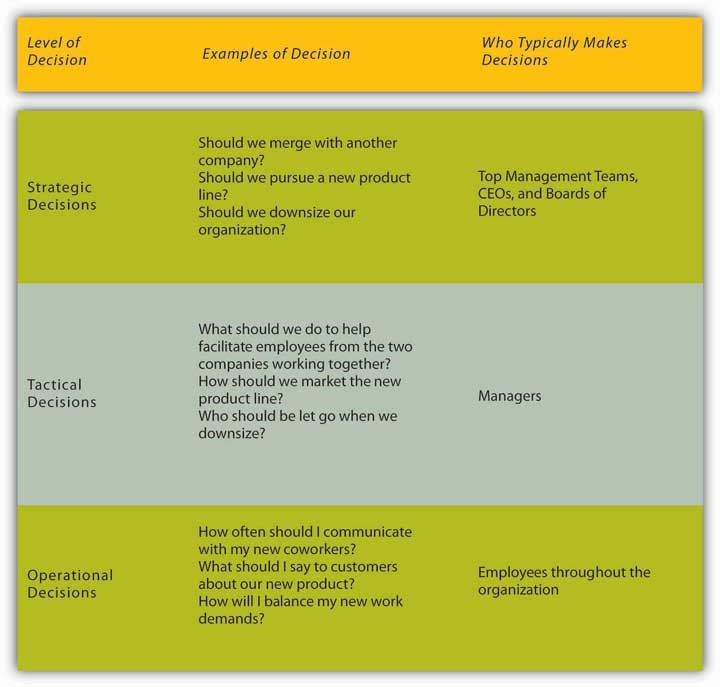
In this chapter, we are going to discuss different decision-making models designed to understand and evaluate the effectiveness of nonprogrammed decisions. We will cover four decision-making approaches starting with the rational decision-making model, moving to the bounded rationality decision-making model, the intuitive decision-making model, and ending with the creative decision-making model.
Making Rational Decisions
The rational decision-making model describes a series of steps that decision makers should consider if their goal is to maximize the quality of their outcomes. In other words, if you want to make sure you make the best choice, going through the formal steps of the rational decision-making model may make sense.
Let’s imagine that your old, clunky car has broken down and you have enough money saved for a substantial down payment on a new car. It is the first major purchase of your life, and you want to make the right choice. The first step, therefore, has already been completed—we know that you want to buy a new car. Next, in step 2, you’ll need to decide which factors are important to you. How many passengers do you want to accommodate? How important is fuel economy to you? Is safety a major concern? You only have a certain amount of money saved, and you don’t want to take on too much debt, so price range is an important factor as well. If you know you want to have room for at least five adults, get at least 20 miles per gallon, drive a car with a strong safety rating, not spend more than $22,000 on the purchase, and like how it looks, you’ve identified the decision criteria. All of the potential options for purchasing your car will be evaluated against these criteria.
Figure 11.7

Using the rational decision-making model to make major purchases can help avoid making poor choices.
Lars Plougmann – Headshift business card discussion – CC BY-SA 2.0.
Before we can move too much further, you need to decide how important each factor is to your decision in step 3. If each is equally important, then there is no need to weight them, but if you know that price and gas mileage are key factors, you might weight them heavily and keep the other criteria with medium importance. Step 4 requires you to generate all alternatives about your options. Then, in step 5, you need to use this information to evaluate each alternative against the criteria you have established. You choose the best alternative (step 6) and you go out and buy your new car (step 7).
Of course, the outcome of this decision will be related to the next decision made; that is where the evaluation in step 8 comes in. For example, if you purchase a car but have nothing but problems with it, you are unlikely to consider the same make and model in purchasing another car the next time!
Figure 11.8 Steps in the Rational Decision-Making Model
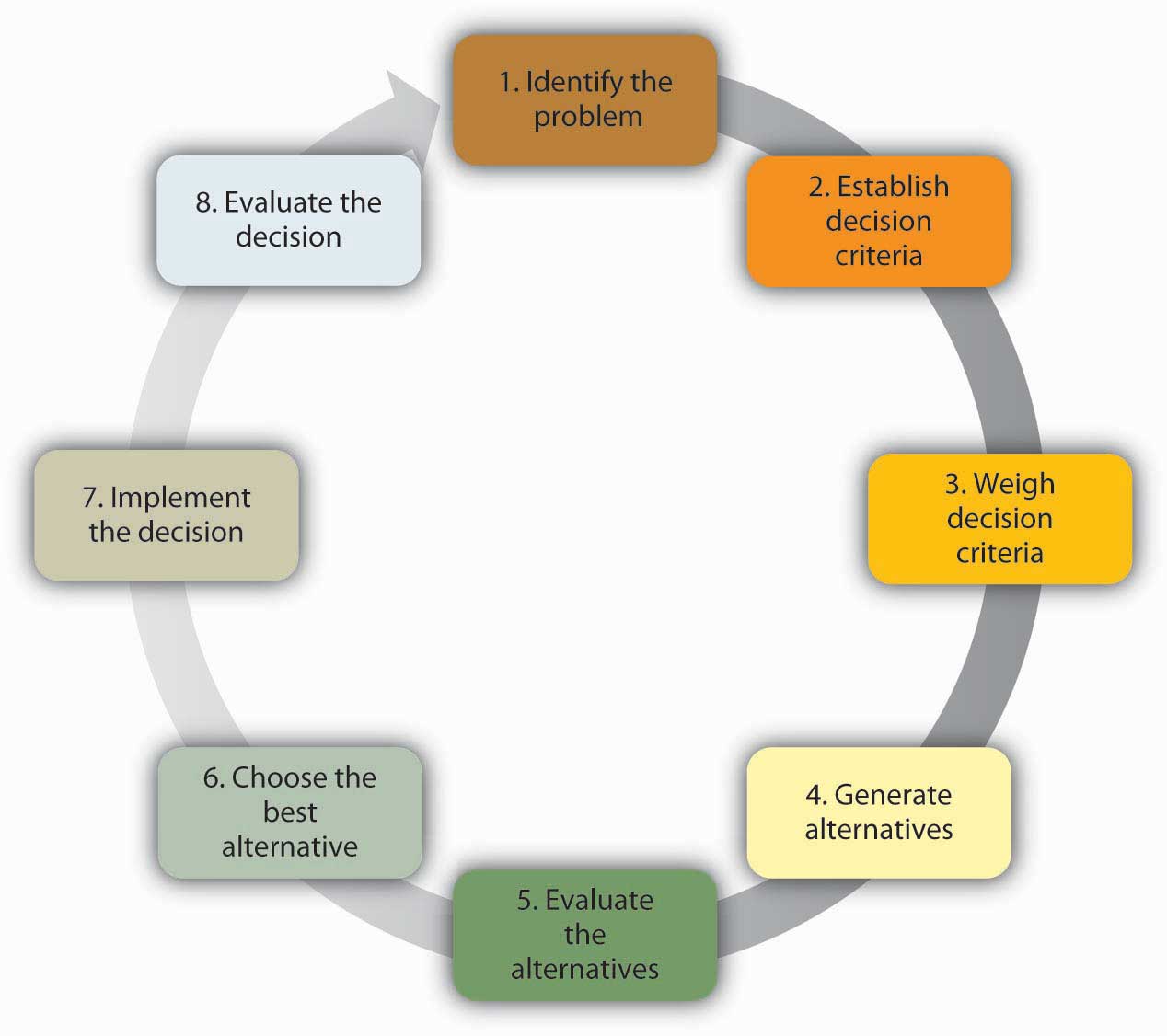
While decision makers can get off track during any of these steps, research shows that limiting the search for alternatives in the fourth step can be the most challenging and lead to failure. In fact, one researcher found that no alternative generation occurred in 85% of the decisions studied (Nutt, 1994). Conversely, successful managers are clear about what they want at the outset of the decision-making process, set objectives for others to respond to, carry out an unrestricted search for solutions, get key people to participate, and avoid using their power to push their perspective (Nutt, 1998).
The rational decision-making model has important lessons for decision makers. First, when making a decision you may want to make sure that you establish your decision criteria before you search for all alternatives. This would prevent you from liking one option too much and setting your criteria accordingly. For example, let’s say you started browsing for cars before you decided your decision criteria. You may come across a car that you think really reflects your sense of style and make an emotional bond with the car. Then, because of your love for this car, you may say to yourself that the fuel economy of the car and the innovative braking system are the most important criteria. After purchasing it, you may realize that the car is too small for all of your friends to ride in the back seat when you and your brother are sitting in front, which was something you should have thought about! Setting criteria before you search for alternatives may prevent you from making such mistakes. Another advantage of the rational model is that it urges decision makers to generate all alternatives instead of only a few. By generating a large number of alternatives that cover a wide range of possibilities, you are likely to make a more effective decision in which you do not need to sacrifice one criterion for the sake of another.
Despite all its benefits, you may have noticed that this decision-making model involves a number of unrealistic assumptions. It assumes that people understand what decision is to be made, that they know all their available choices, that they have no perceptual biases, and that they want to make optimal decisions. Nobel Prize–winning economist Herbert Simon observed that while the rational decision-making model may be a helpful tool for working through problems, it doesn’t represent how decisions are frequently made within organizations. In fact, Simon argued that it didn’t even come close!
Think about how you make important decisions in your life. Our guess is that you rarely sit down and complete all eight steps in the rational decision-making model. For example, this model proposed that we should search for all possible alternatives before making a decision, but this can be time consuming and individuals are often under time pressure to make decisions. Moreover, even if we had access to all the information, it could be challenging to compare the pros and cons of each alternative and rank them according to our preferences. Anyone who has recently purchased a new laptop computer or cell phone can attest to the challenge of sorting through the different strengths and limitations of each brand, model, and plans offered for support and arriving at the solution that best meets their needs.
In fact, the availability of too much information can lead to analysis paralysis , where more and more time is spent on gathering information and thinking about it, but no decisions actually get made. A senior executive at Hewlett-Packard admits that his company suffered from this spiral of analyzing things for too long to the point where data gathering led to “not making decisions, instead of us making decisions (Zell, et. al., 2007).” Moreover, you may not always be interested in reaching an optimal decision. For example, if you are looking to purchase a house, you may be willing and able to invest a great deal of time and energy to find your dream house, but if you are looking for an apartment to rent for the academic year, you may be willing to take the first one that meets your criteria of being clean, close to campus, and within your price range.
Making “Good Enough” Decisions
The bounded rationality model of decision making recognizes the limitations of our decision-making processes. According to this model, individuals knowingly limit their options to a manageable set and choose the best alternative without conducting an exhaustive search for alternatives. An important part of the bounded rationality approach is the tendency to satisfice , which refers to accepting the first alternative that meets your minimum criteria. For example, many college graduates do not conduct a national or international search for potential job openings; instead, they focus their search on a limited geographic area and tend to accept the first offer in their chosen area, even if it may not be the ideal job situation. Satisficing is similar to rational decision making, but it differs in that rather than choosing the best choice and maximizing the potential outcome, the decision maker saves time and effort by accepting the first alternative that meets the minimum threshold.
Making Intuitive Decisions
The intuitive decision-making model has emerged as an important decision-making model. It refers to arriving at decisions without conscious reasoning. Eighty-nine percent of managers surveyed admitted to using intuition to make decisions at least sometimes, and 59% said they used intuition often (Burke & Miller, 1999). When we recognize that managers often need to make decisions under challenging circumstances with time pressures, constraints, a great deal of uncertainty, highly visible and high-stakes outcomes, and within changing conditions, it makes sense that they would not have the time to formally work through all the steps of the rational decision-making model. Yet when CEOs, financial analysts, and healthcare workers are asked about the critical decisions they make, seldom do they attribute success to luck. To an outside observer, it may seem like they are making guesses as to the course of action to take, but it turns out that they are systematically making decisions using a different model than was earlier suspected. Research on life-or-death decisions made by fire chiefs, pilots, and nurses finds that these experts do not choose among a list of well-thought-out alternatives. They don’t decide between two or three options and choose the best one. Instead, they consider only one option at a time. The intuitive decision-making model argues that, in a given situation, experts making decisions scan the environment for cues to recognize patterns (Breen, 2000; Klein, 2003; Salas & Klein, 2001). Once a pattern is recognized, they can play a potential course of action through to its outcome based on their prior experience. Due to training, experience, and knowledge, these decision makers have an idea of how well a given solution may work. If they run through the mental model and find that the solution will not work, they alter the solution and retest it before setting it into action. If it still is not deemed a workable solution, it is discarded as an option and a new idea is tested until a workable solution is found. Once a viable course of action is identified, the decision maker puts the solution into motion. The key point is that only one choice is considered at a time. Novices are not able to make effective decisions this way because they do not have enough prior experience to draw upon.
Making Creative Decisions
In addition to the rational decision making, bounded rationality models, and intuitive decision making, creative decision making is a vital part of being an effective decision maker. Creativity is the generation of new, imaginative ideas. With the flattening of organizations and intense competition among organizations, individuals and organizations are driven to be creative in decisions ranging from cutting costs to creating new ways of doing business. Please note that, while creativity is the first step in the innovation process, creativity and innovation are not the same thing. Innovation begins with creative ideas, but it also involves realistic planning and follow-through.
The five steps to creative decision making are similar to the previous decision-making models in some keys ways. All of the models include problem identification , which is the step in which the need for problem solving becomes apparent. If you do not recognize that you have a problem, it is impossible to solve it. Immersion is the step in which the decision maker thinks about the problem consciously and gathers information. A key to success in creative decision making is having or acquiring expertise in the area being studied. Then, incubation occurs. During incubation, the individual sets the problem aside and does not think about it for a while. At this time, the brain is actually working on the problem unconsciously. Then comes illumination or the insight moment, when the solution to the problem becomes apparent to the person, usually when it is least expected. This is the “eureka” moment similar to what happened to the ancient Greek inventor Archimedes, who found a solution to the problem he was working on while he was taking a bath. Finally, the verification and application stage happens when the decision maker consciously verifies the feasibility of the solution and implements the decision.
A NASA scientist describes his decision-making process leading to a creative outcome as follows: He had been trying to figure out a better way to de-ice planes to make the process faster and safer. After recognizing the problem, he had immersed himself in the literature to understand all the options, and he worked on the problem for months trying to figure out a solution. It was not until he was sitting outside of a McDonald’s restaurant with his grandchildren that it dawned on him. The golden arches of the “M” of the McDonald’s logo inspired his solution: he would design the de-icer as a series of M’s! 1 This represented the illumination stage. After he tested and verified his creative solution, he was done with that problem except to reflect on the outcome and process.
Figure 11.9 The Creative Decision-Making Process

How Do You Know If Your Decision-Making Process Is Creative?
Researchers focus on three factors to evaluate the level of creativity in the decision-making process. Fluency refers to the number of ideas a person is able to generate. Flexibility refers to how different the ideas are from one another. If you are able to generate several distinct solutions to a problem, your decision-making process is high on flexibility. Originality refers to an idea’s uniqueness. You might say that Reed Hastings, founder and CEO of Netflix, is a pretty creative person. His decision-making process shows at least two elements of creativity. We do not exactly know how many ideas he had over the course of his career, but his ideas are fairly different from one another. After teaching math in Africa with the Peace Corps, Hastings was accepted at Stanford University, where he earned a master’s degree in computer science. Soon after starting work at a software company, he invented a successful debugging tool, which led to his founding the computer troubleshooting company Pure Software in 1991. After a merger and the subsequent sale of the resulting company in 1997, Hastings founded Netflix, which revolutionized the DVD rental business through online rentals with no late fees. In 2007, Hastings was elected to Microsoft’s board of directors. As you can see, his ideas are high in originality and flexibility (Conlin, 2007).
Figure 11.10 Dimensions of Creativity
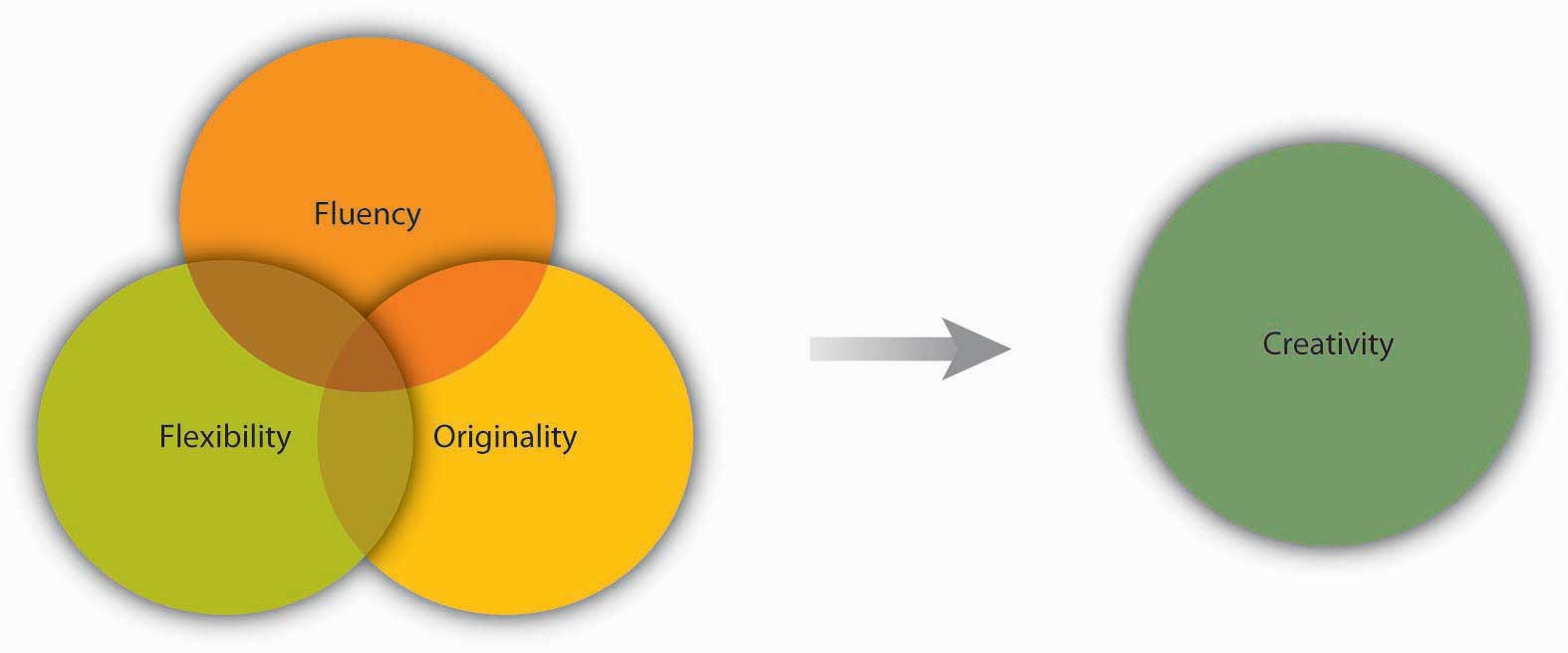
Some experts have proposed that creativity occurs as an interaction among three factors: (1) people’s personality traits (openness to experience, risk taking), (2) their attributes (expertise, imagination, motivation), and (3) the context (encouragement from others, time pressure, and physical structures) (Amabile, 1988; Amabile, et. al., 1996; Ford & Gioia, 2000; Tierney, et. al., 1999; Woodman, et. al., 1993). For example, research shows that individuals who are open to experience, are less conscientious, more self-accepting, and more impulsive, tend to be more creative (Feist, 1998).
There are many techniques available that enhance and improve creativity. Linus Pauling, the Nobel prize winner who popularized the idea that vitamin C could help build the immunity system, said, “The best way to have a good idea is to have a lot of ideas.” One popular way to generate ideas is to use brainstorming. Brainstorming is a group process of generated ideas that follows a set of guidelines that include no criticism of ideas during the brainstorming process, the idea that no suggestion is too crazy, and building on other ideas (piggybacking). Research shows that the quantity of ideas actually leads to better idea quality in the end, so setting high idea quotas where the group must reach a set number of ideas before they are done, is recommended to avoid process loss and to maximize the effectiveness of brainstorming. Another unique aspect of brainstorming is that the more people are included in brainstorming, the better the decision outcome will be because the variety of backgrounds and approaches give the group more to draw from. A variation of brainstorming is wildstorming where the group focuses on ideas that are impossible and then imagines what would need to happen to make them possible (Scott, et. al., 2004).
Ideas for Enhancing Organizational Creativity
We have seen that organizational creativity is vital to organizations. Here are some guidelines for enhancing organizational creativity within teams (Amabile, 1998; Gundry, et. al., 1994; Keith, 2008; Pearsall, et. al., 2008; Thompson, 2003).
Team Composition (Organizing/Leading)
- Diversify your team to give them more inputs to build on and more opportunities to create functional conflict while avoiding personal conflict.
- Change group membership to stimulate new ideas and new interaction patterns.
- Leaderless teams can allow teams freedom to create without trying to please anyone up front.
Team Process (Leading)
- Engage in brainstorming to generate ideas—remember to set a high goal for the number of ideas the group should come up with, encourage wild ideas, and take brainwriting breaks.
- Use the nominal group technique in person or electronically to avoid some common group process pitfalls. Consider anonymous feedback as well.
- Use analogies to envision problems and solutions.
Leadership (Leading)
- Challenge teams so that they are engaged but not overwhelmed.
- Let people decide how to achieve goals , rather than telling them what goals to achieve.
- Support and celebrate creativity even when it leads to a mistake. But set up processes to learn from mistakes as well.
- Model creative behavior.
Culture (Organizing)
- Institute organizational memory so that individuals do not spend time on routine tasks.
- Build a physical space conducive to creativity that is playful and humorous—this is a place where ideas can thrive.
- Incorporate creative behavior into the performance appraisal process.
And finally, avoiding groupthink can be an important skill to learn (Janis, 1972).
The four different decision-making models—rational, bounded rationality, intuitive, and creative—vary in terms of how experienced or motivated a decision maker is to make a choice. Choosing the right approach will make you more effective at work and improve your ability to carry out all the P-O-L-C functions.
Figure 11.11
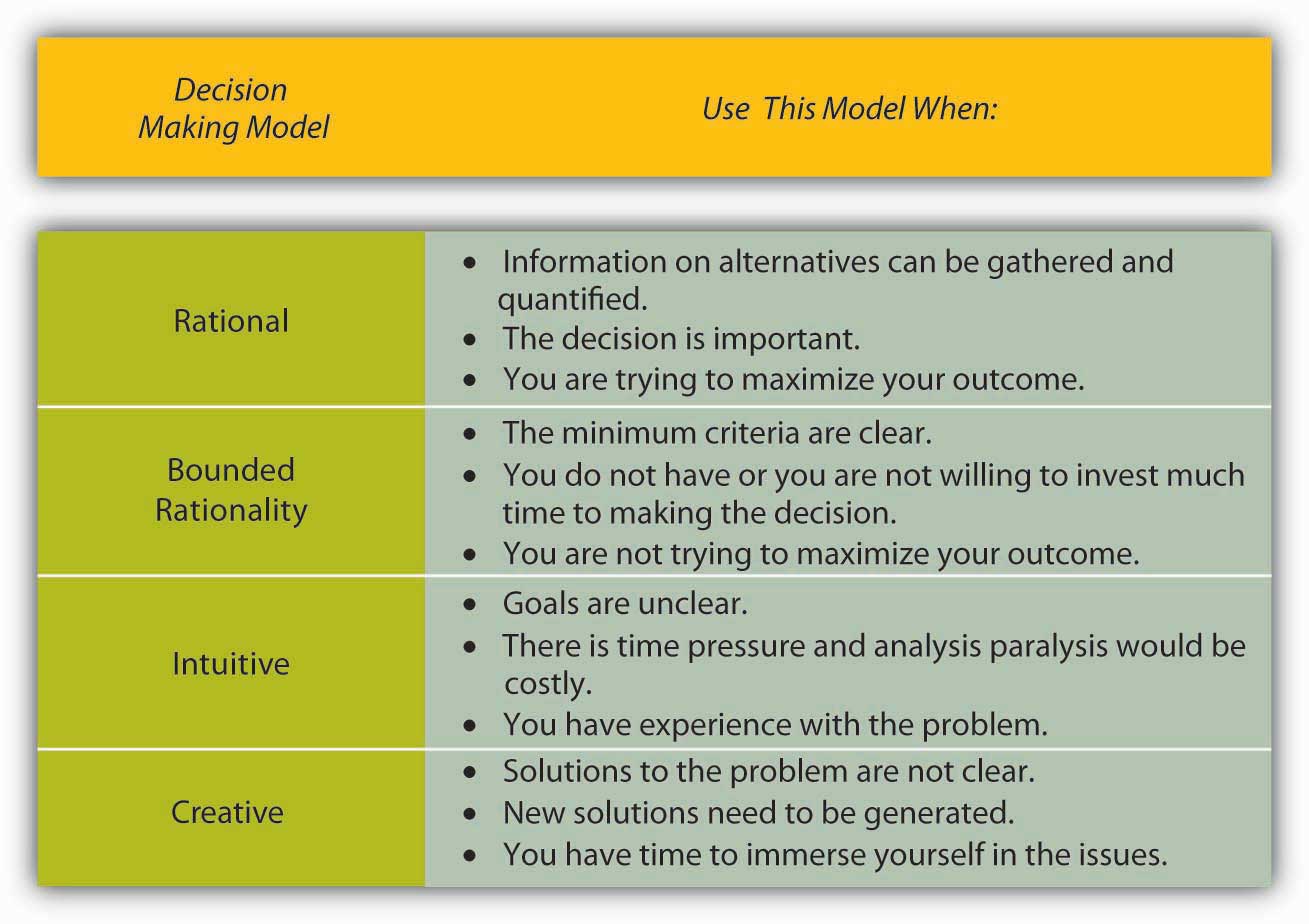
Which decision-making model should I use?
Key Takeaway
Decision making is choosing among alternative courses of action, including inaction. There are different types of decisions, ranging from automatic, programmed decisions to more intensive nonprogrammed decisions. Structured decision-making processes include rational decision making, bounded rationality, intuitive, and creative decision making. Each of these can be useful, depending on the circumstances and the problem that needs to be solved.
- What do you see as the main difference between a successful and an unsuccessful decision? How much does luck versus skill have to do with it? How much time needs to pass to answer the first question?
- Research has shown that over half of the decisions made within organizations fail. Does this surprise you? Why or why not?
- Have you used the rational decision-making model to make a decision? What was the context? How well did the model work?
- Share an example of a decision where you used satisficing. Were you happy with the outcome? Why or why not? When would you be most likely to engage in satisficing?
- Do you think intuition is respected as a decision-making style? Do you think it should be? Why or why not?
1 Interview by author Talya Bauer at Ames Research Center, Mountain View, CA, 1990.
Amabile, T. M. (1988). A model of creativity and innovation in organizations. In B. M. Staw & L. L. Cummings (Eds.), Research in Organizational Behavior, 10 123–167 Greenwich, CT: JAI Press.
Amabile, T. M., Conti, R., Coon, H., Lazenby, J., & Herron, M. (1996). Assessing the work environment for creativity. Academy of Management Journal, 39 , 1154–1184.
Amabile, T. M. (1998). How to kill creativity. Harvard Business Review, 76 , 76–87.
Blanchard, K., & Peale, N. V. (1988). The power of ethical management . New York: William Morrow.
Breen, B. (2000, August), “What’s your intuition?” Fast Company , 290.
Burke, L. A., & Miller, M. K. (1999). Taking the mystery out of intuitive decision making. Academy of Management Executive, 13 , 91–98.
Conlin, M. (2007, September 14). Netflix: Recruiting and retaining the best talent. Business Week Online . Retrieved March 1, 2008, from http://www.businessweek.com/managing/content/sep2007/ca20070913_564868.htm?campaign_id=rss_null .
Feist, G. J. (1998). A meta-analysis of personality in scientific and artistic creativity. Personality and Social Psychology Review, 2 , 290–309.
Ford, C. M., & Gioia, D. A. (2000). Factors influencing creativity in the domain of managerial decision making. Journal of Management, 26 , 705–732.
Garvin, D. A. (2006, January). All the wrong moves. Harvard Business Review , 18–23.
Gundry, L. K., Kickul, J. R., & Prather, C. W. (1994). Building the creative organization. Organizational Dynamics , 22 , 22–37.
Ireland, R. D., & Miller, C. C. (2004). Decision making and firm success. Academy of Management Executive, 18 , 8–12.
Janis, I. L. (1972). Victims of groupthink . New York: Houghton Mifflin; Whyte, G. (1991). Decision failures: Why they occur and how to prevent them. Academy of Management Executive, 5 , 23–31.
Keith, N., & Frese, M. (2008). Effectiveness of error management training: A meta-analysis. Journal of Applied Psychology, 93 , 59–69.
Klein, G. (2001). Linking expertise and naturalistic decision making . Mahwah, NJ: Lawrence Erlbaum.
Klein, G. (2003). Intuition at work . New York: Doubleday; Salas, E., &.
Nutt, P. C. (1994). Types of organizational decision processes. Administrative Science Quarterly, 29 , 414–550.
Nutt, P. C. (1998). Surprising but true: Half the decisions in organizations fail. Academy of Management Executive, 13 , 75–90.
Nutt, P. C. (2002). Why decisions fail . San Francisco: Berrett-Koehler.
Pearsall, M. J., Ellis, A. P. J., & Evans, J. M. (2008). Unlocking the effects of gender faultlines on team creativity: Is activation the key? Journal of Applied Psychology, 93 , 225–234.
Scott, G., Leritz, L. E., & Mumford, M. D. (2004). The effectiveness of creativity training: A quantitative review. Creativity Research Journal, 16 , 361–388.
Thompson, L. (2003). Improving the creativity of organizational work groups. Academy of Management Executive, 17 , 96–109.
Tierney, P., Farmer, S. M., & Graen, G. B. (1999). An examination of leadership and employee creativity: The relevance of traits and relationships. Personnel Psychology, 52 , 591–620.
Woodman, R. W., Sawyer, J. E., & Griffin, R. W. (1993). Toward a theory of organizational creativity. Academy of Management Review, 18 , 293–321.
Zell, D. M., Glassman, A. M., & Duron, S. A. (2007). Strategic management in turbulent times: The short and glorious history of accelerated decision making at Hewlett-Packard. Organizational Dynamics, 36 , 93–104.
Principles of Management Copyright © 2015 by University of Minnesota is licensed under a Creative Commons Attribution-NonCommercial-ShareAlike 4.0 International License , except where otherwise noted.
- Project Management Tools
What is rational decision-making? What are the steps?

By Hadrat Ajao 4 min read · Posted Mar 25, 2024
Decision-making is undertaken by individuals daily, revolving around what to eat, what to wear, whether to go somewhere, what to read, etc. A decision-making process preempts every human action.
The rational decision-making process is often employed when making choices or decisions. The process is based on logic, reason, and carefully considering available information and options. It is a structured approach to making decisions, and it aims to optimize outcomes and reduce the impacts of biases and emotions in decision-making. When a decision is preceded by rational thinking, the results are often a desired outcome and serve a greater good.
This article will review an example of how Lauren utilized rational decision-making.
Lauren is a successful freelancer who has had a particularly successful year in her career. There has been a surge in her clientele. While this is exciting, it also brings some challenges. Lauren needs to make a decision that will significantly shape her future. The surge in her clientele brings both exciting opportunities and challenging choices.
As the offers pour in, one particularly lucrative deal requires Lauren to transition from her cozy home office to a dedicated workspace. The international client offering this two-year contract needs regular face-to-face meetings on a video call, requiring investment in a professional work office with whiteboards and big screen monitors. She had previously worked from her one-room space, but now she needs to build a professional office space. This proposition coincides with a turning point in Lauren's aspirations.
Lauren was planning to purchase a luxurious car, symbolizing her success. The allure of a vehicle that mirrors her blossoming career beckons her. Yet, the decision looms as she realizes that committing to the needed professional office space means putting her automotive dreams on hold. Lauren is torn between two significant investments promising to enhance her professional and personal life. Here, the rational decision-making process becomes Lauren's guiding light.
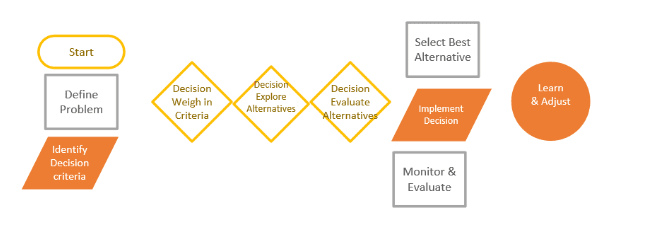
1. Defining the problem: First, Lauren needs to clearly define the issue, which is the decision between spending on office space for her growing clientele vs. Buying a luxurious car.
2. Identifying decision criteria: Next, Lauren determines the key factors influencing her decision, considering the long-term benefits of securing the international deal versus the immediate satisfaction of owning a prestigious car.
3. Weighing in the decision criteria: Lauren assigns a weight to each criterion, acknowledging the potential impact on her career trajectory and personal satisfaction.
4. Exploring alternatives: Lauren explores various scenarios, including negotiating with her clients for a compromise to accommodate their needs and fulfill her aspirations.
5. Evaluating alternatives: She objectively assesses the pros and cons of each alternative, weighing the consequences of delaying the car purchase against the potential gains from securing a long-term client commitment.
6. Selecting the best alternative: With a comprehensive analysis, Lauren makes an informed decision aligning with her goals and priorities.
7. Implementing the decision: Lauren takes the necessary steps to either sign the deal, negotiate terms, or pursue an alternative that suits her clients and satisfies her desires.
8. Monitoring and evaluating: With the decision put in action, Lauren stays vigilant, monitoring the outcomes and adjusting her approach to ensure continued success.
9. Learning and adjusting: Lauren reflects on the experience, learning valuable lessons about balancing professional growth and personal fulfillment. This newfound wisdom guides her future decisions as she navigates the evolving landscape of her freelance career.
By following the rational decision-making steps, Lauren transforms a challenging situation into a strategic choice that aligns with her goals and ensures a sustainable and fulfilling path forward.
Faced with the conflicting choices of building a dedicated office space or the allure of buying a luxurious car, Lauren embarked on a journey of introspection guided by the principles of rational decision-making. The weight of her decision hung in the balance, with the potential to shape her professional trajectory and personal satisfaction. After carefully considering the options and thoroughly evaluating the associated criteria, Lauren chose a path harmonizing with her overarching goals.
Recognizing the transformative potential of the international deal and the enduring impact it could have on her burgeoning career, she boldly decided to prioritize building a dedicated office space.
This choice, rooted in rational analysis, reflected Lauren's commitment to long-term success and her understanding of the sacrifices required for sustained growth. While Lauren temporarily put the luxurious car on hold, she embraced the opportunity to cultivate a thriving professional environment that would undoubtedly yield long-term gains, making her dreams of owning a luxurious car a reality soon enough.
In making this decision, Lauren demonstrated her business acumen, resilience, and foresight. The narrative of her freelance journey had evolved, and with this strategic move, she set the stage for continued prosperity. Lauren embraced her new professional chapter with a sense of purpose and the confidence that comes from deliberate decision-making. Lauren's success was not just about the projects she tackled or the words she penned; it was a testament to her ability to navigate complex choices with wisdom, ensuring a trajectory that promised financial gains and personal fulfillment.
In the grand tapestry of her freelance career, this decision stood out as a defining moment, a testament to Lauren's strategic thinking and unwavering commitment to building a legacy beyond the glossy allure of immediate rewards.
Rational decision-making is an important function especially in the Human Resources management area. This book on Rational Decisions in Organisations details the science and art behind it.
About The Author

Hadrat Ajao
Hello, I am Hadrat, a communication specialist and an article writer for Pitch Labs. I am passionate about street children and abandoned women, with a special focus on the African terrain. I enjoy writing poems and creative stories.
Join Our Community
Looking for something else? Get your questions answered in our free online learning community!
Entrepreneurial Resources
Jumpstart your next business with our free resource library.
- Getting Started
- Business Plans
- Document Types
- Keeping Records
- Protections
- Regulations
- Entrepreneurship
- Product & Service Management
- Human Resources
- Social Media Tools
- Advertising
- United States of America
- Applications
- Website Building Tools
- Recruitment
Our organization cannot give out official legal/fiscal guidance. All articles are written by volunteers and it may be beneficial to contact professionals to assist your understanding of the information and to guide your action. Pitch Labs bears no responsibility for the results of actions taken based off of article content or any other form of assistance given.
More in Operations
Operations » Human Resources
What is Cognitive Conflict?
Cognitive conflict is the anxiety and tension that affects an individual when cognitive dissonance occurs. Managing such conflict is essential in the workplace. Read more
Technology » Recruitment
What is the role of technology in recruitment?
Overall, technology enhances the recruitment experience for employers and candidates alike, optimizing every step from application to hiring. Read more
Operations » Project Management Tools
What is Stakeholder Management in Project Management?
This piece details what a stakeholder is, the relevance to project management, and how to manage stakeholders to run a smooth project. Read more
What are the psychological states that help employees feel motivated?
The main psychological states that help employees feel motivated include knowledge of results, experienced meaningfulness, and experienced responsibility. This blog post looks at each of these states and what’s involved in them.. Read more
Recent articles
Legal » Structures
What is an NGO? Are they typically nonprofits? What are the features of an NGO?
An NGO is an independent, nonprofit organization that promotes humanitarian or social missions throughout the globe. Read more
Legal » Protections
Patent Filing: A Step-By-Step Guide
A patent is a legal protection granted to inventors to protect their intellectual property. Read more
Technology » Applications
How can technology be used to reach consumers?
Technology is vital to connect with consumers effectively. Here are six ways technology can facilitate consumer engagement. Read more
- What is i-nexus
- Why i-nexus
- Strategy Execution
- Hoshin Kanri
- Operational excellence
- Case studies
- i-nexus reviews
- Strategy execution guide
- Hoshin Kanri guide
- Operational excellence guide
- Book a demo
- Demo on-demand
- Plan to practice
- Buy or build
- Customer success overview
- Customer success journey
- Customer services
- Customer support
- News & Press
8 types of strategic planning models you should be using
While classical strategic planning models are effective in traditional markets and environments, we no longer live in this world. to thrive here requires planners to evolve and adapt their practices. find out why one strategic planning model - hybrid - stands head and shoulders above the rest..
Agile has pushed beyond its roots in software development and into other functions in the business. With it comes a fresh workstream or project management approach, the promise of “continuous” delivery, and greater responsiveness to change.
But can agile principles also be applied to strategy and strategic planning?
In this age of uncertainty and volatility, strategic planning surely would benefit from increased responsiveness.
This blog explores eight strategic planning models to find those that will support your organization to be continuous - and adaptive - when it comes to a continuous approach to strategy.
Classic types of strategic planning
Three classical strategic planning models are rational, incremental, and organic.
1. The rational model of strategic planning
The rational model is a top-down, step-by-step process in which a company analyzes its industry, competitors, and environment to identify opportunities and threats.
It then develops strategies to take advantage of the opportunities and address the threats.
The benefits of a rational model
This rational model is beneficial because it allows for a systematic and analytical approach to decision-making in your organization.
It also helps to ensure that all possible outcomes are considered and that the best course of action is chosen based on available information.
Additionally, a rational model encourages planners to think ahead and anticipate potential problems or challenges.
The challenges of a rational model
However, the rational theoretical framework assumes that managers are fully informed, able to calculate the best course of action, and motivated to act in the best interests of their firm.
While this may be a reasonable assumption in some cases, it does not reflect the reality of many business environments.
Managerial decision-making is often influenced by biases, emotions, and personal agendas, which can lead to suboptimal outcomes.
In addition, complex systems cannot be accurately modeled using rational analysis alone, so managers must rely on their intuition and experience to make decisions in uncertain situations.
2. The incremental model of strategic planning
The incremental model is also a top-down process but is more flexible than the rational model.
The company begins by identifying its goals and objectives and developing strategies to achieve them.
The benefits of an incremental model
An incremental strategic planning model is beneficial because it allows for continuous refinement and adjustment to the plan as new information arises.
This helps ensure that the plan is always aligned with the current reality and can be adapted as necessary.
Additionally, an incremental model allows for a more participatory planning process, leading to a better understanding and buy-in from all stakeholders.
The challenges of an incremental model
A few challenges are associated with using an incremental strategic planning model.
One is that it can be difficult to maintain momentum and keep all stakeholders aligned and committed to the plan if changes are made incrementally.
Another challenge is that it can be difficult to accurately forecast future needs and trends if changes are too slow.
Finally, it can be difficult to get buy-in from all stakeholders for a constantly evolving plan; therefore, it's crucial to take stakeholders through the continuous strategy manifesto .
3. The organic model of strategic planning
The organic model is a bottom-up process in which the company allows employees to develop ideas for improving the business.
Employees then develop strategies to implement these ideas.
An organic strategic planning model is beneficial because it allows for a flexible and adaptable plan to grow and change along with the organization.
It also allows for input and feedback from employees at all levels, which can help ensure that the plan meets the organization's and its employees' needs.
The challenges of an organic model of strategic planning are many.
One key challenge is that organic planning models rely on accurate and timely information, which can be difficult to obtain and process.
Additionally, the decision-making process in an organic model is often slower than in a traditional top-down model, which can lead to missed opportunities.
Furthermore, the lack of a clear hierarchy can make it difficult to assign responsibility and accountability for strategic decisions.
Finally, the participatory nature of organic planning can lead to conflict and gridlock if stakeholders have different visions for the organization's future.
4. Strategic alignment model
The strategic alignment model is a tool that can be used to help your organization ensure its strategies align closely with operational goals. This is often seen through the Hoshin Kanri model.
The four steps of the strategic alignment model are to: 1. Establish the organization's mission and vision. 2. Determine the organization's strategic goals and objectives. 3. Develop strategies to achieve the strategic goals and objectives. 4. Evaluate the effectiveness of the strategies and make necessary adjustments.
The benefits of the strategic alignment model
The benefits of the strategic alignment model are that it helps organizations to identify and focus on their critical success factors and also allows them to measure their progress in achieving these factors.
Additionally, the model can help organizations identify and manage any gaps between their actual and desired states.
The challenges of the strategic alignment model
Because the strategic alignment model aims to get the enterprise working towards the same goal, by its very essence, this is challenging as different areas may have different goals. This can make it hard to agree on what the goal should be.
To this end, strategic planners can use the catchball goal-setting method , and supplement it with the "W" process for strategic planning
Additionally, the strategic alignment model can be difficult to implement because it requires cooperation between all departments. If one department is not working together with the others, it can disrupt the entire plan. Culture hacking is a key means to overcome a silo, tribal mentality in your organization.

Testing the degree to which your business is strategically aligned (and therefore an early indicator of how this model may or may not work for you) is HBR's two-part question :
“1. How well does your business strategy support the fulfillment of your company’s purpose? 2. How well does your organization support the achievement of your business strategy?" Trevor and Varcoe, "A simple way to test your company's strategic alignment", Harvard Business Review 2016
5. The basic strategic planning model
The basic (or simple) model is the right place to start for organizations that are novices or new to structured strategic planning.
While it is best suited to those planners working in businesses with little to no history of strategic planning, it is also an effective framework for any organization that doesn’t have the time or resources to spend on deep and extensive strategic planning.
The basic strategic planning model provides structure and guidance for developing and implementing a successful strategy.
The model consists of four steps:
1. Situation analysis 2. Goal setting 3. Strategy creation, and 4. Implementation and monitoring. Situational analysis
The first step, situation analysis, involves conducting a thorough assessment of the current environment and identifying the key factors that will impact the organization's success.
This step is important because it provides a foundation for setting realistic goals and developing effective strategies. Goal setting
The second step, goal setting, involves establishing specific objectives the organization hopes to achieve.
These objectives should be SMART: Specific, Measurable, Achievable, Relevant, and Time-bound. Strategy creation
The third step, strategy development, involves crafting a plan of action to help the organization reach its objectives.
This step requires careful consideration of the resources available and the constraints faced by the organization and could be any of these strategies . Implementation and monitoring
The fourth step, implementation and monitoring involve putting the strategy into action and tracking progress toward the objectives.
This step requires ongoing communication and coordination among all members of the organization.
The benefits of the basic strategic planning model
A basic strategic planning model can help a company or organization clarify its purpose, identify its strengths and weaknesses, and determine its goals and strategies.
Creating a strategic plan can help management better understand the business, identify potential opportunities and threats, and assess the company's current position in the market.
Having a clear and well-defined strategy can help a company focus its resources and improve its chances of success.
The challenges of the basic strategic planning model
Basic strategic planning models can be challenging to implement, especially for organizations that have never attempted formal strategic planning.
Creating a mission statement , outlining objectives and strategies, and developing action plans can be overwhelming for some groups.
Additionally, it can be difficult to focus on the strategic planning process and resist the temptation to rush into implementation. Another challenge is ensuring that everyone in the organization buys into the plan.
This involves getting input from all levels of the company and ensuring that everyone understands and agrees with the objectives and strategies. It can also be difficult to keep everyone on track once the plan is implemented.
Finally, it is important to regularly review and update the plan to remain relevant and effective.

Three continuous types of strategic planning
While classical types of strategic planning are advantageous in their ability to align your business around goals, inspire belief in achieving them, and give structure to strategic implementation - they're static.
These common strategic planning models, bar the incremental approach, fail to help you successfully adapt to your surroundings.
That is why your organization's best approach to strategic planning lies in continuous strategic models like those we'll outline now.
What does continuous strategic planning mean?
In many senses, it means incremental planning and delivery.
Traditionally, annual strategic planning involves considerable upfront planning followed by a 12-month program of delivery.
Any reviews during delivery are focused on performance against this plan.
A more agile approach to strategic planning advocates a continuous approach to planning and delivery.
Such an agile approach negates the need to plan a year’s worth of strategic activity while creating regular opportunities to review progress and plan the next activity increment.
What’s attractive about this approach is the ability to course correct or even pivot to respond to changing internal or external environmental factors.
What are the three models of continuous strategic planning?
To help answer that question, let’s explore three models:
1. Annual planning
This is the traditional approach to strategic planning.
Strategic plans are developed in cadence with the financial year.
Strategic objectives and their supporting workstreams are determined and planned before embarking on the plan.
The “planning cycle” is the same as the “delivery cycle.” Battle-tested, this model is reliable and well-understood.
However, it lacks that responsiveness to uncertainty and might sometimes feel like a blind race to the finish line.
The benefits of annual planning
There are many benefits to annual planning.
One of the biggest benefits is that it allows you to track your progress over the year. You can see what goals you have accomplished and what needs to be done. This can help you stay on track and ensure you reach your goals.
Annual planning can also help you identify areas of your business that need improvement. You can then take steps to improve these areas. Additionally, annual planning can help you budget for the year ahead.
This will help you make sure you have enough money to accomplish your goals. Lastly, annual planning can help you stay organized and on top of everything that needs to be done.
The challenges of annual planning
One of the challenges of annual planning is ensuring that all stakeholders are on the same page.
This cannot be easy, as different departments may have different priorities.
It is important to ensure that everyone understands the organization's goals and works towards achieving them.
Another challenge is ensuring that the plan is realistic and achievable. This means setting realistic goals and ensuring enough time to accomplish them.
Finally, it is important to evaluate the plan regularly and make changes as needed. This helps ensure that the plan remains effective and relevant.
2. Agile planning
Agile Planning is an iterative and incremental process of planning and monitoring the work that needs to be done to deliver a product or service. It enables teams to respond quickly to changes in customer demand and business conditions.
Applied to strategy, agile means that strategic decisions are made on a much more frequent basis than annual, and any future strategic activity exists in the form of a prioritized list (or backlog) of strategic priorities.
The benefits of agile planning
The benefits of agile planning are that it enables you to respond quickly to changes in the market or customer demands.
It also allows you to prioritize tasks and ensure that the most important tasks are completed first.
Additionally, agile planning helps you to track progress and ensure that you are on track to meet your goals.
The challenges of agile planning
The challenges of agile planning stem from the need to balance the need for predictability and the need for flexibility.
Agile planning requires regular adjustments to plans to account for requirements changes and stakeholders' feedback.
This can be difficult to manage, particularly when stakeholders are unavailable or changes occur rapidly.
There is also a risk that agile planning can lead to over-optimism and unrealistic expectations.
3. Hybrid planning
In a hybrid model, the planning cycle remains annual, but its delivery is managed in a more agile way.
In this model, the annual plan acts as a “north star” for activity, but in-between delivery cycles, priorities for the next delivery cycle are calibrated before the activity proceeds.
The benefits of hybrid planning
Hybrid planning can provide a company with the ability to have a more streamlined and efficient process for both long-term and short-term planning.
By combining the strengths of each approach, a company can develop a plan tailored specifically to its needs.
Additionally, a hybrid plan can help a company stay agile and responsive to changes in the market or industry.
The challenges of hybrid planning
One challenge of hybrid planning is that it can be difficult to strike the right balance between long-term and short-term planning.
Another challenge is that it can be difficult to keep all of the different aspects of the plan organized and coordinated. This, in turn, can lead to challenges around reviewing strategy and adapting to the environment.
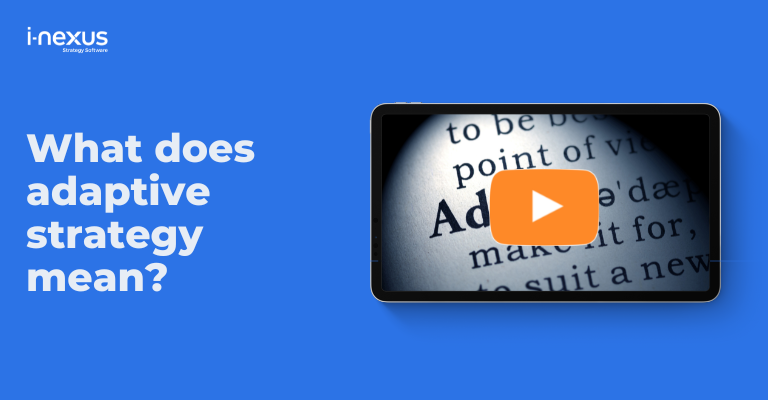
What goes into a strategic planning cycle?
With our understanding of continuous strategic planning models in mind, we can now better understand their similarities and differences. To achieve that, we will consider five planning elements:
1. Planning horizons
A long-term future view of an organization’s strategic direction.
A planning horizon might include overarching breakthrough objectives that an organization aspires to achieve over that timeframe.
Planning horizons might vary significantly between industries.
2. Planning cycles
The period over which strategic activity is planned ahead of delivery.
Traditionally, planning cycles have been aligned with budget cycles.
3. Delivery cycles
An incremental delivery within the planning cycle.
Historically, delivery cycles have been aligned directly with planning cycles.
An annual strategic plan has a twelve-month delivery cycle.
4. Strategic sprints
A short, time-boxed period during which a team works to complete strategic work.
Multiple sprints are delivered throughout a delivery cycle.
5. Strategic reviews
Regular reviews of strategy, progress against strategic plan, and performance to targets.
How do continuous strategic planning models compare?
The comparison below shows that all three models share the same planning horizon element, typically 2-5 years in duration.
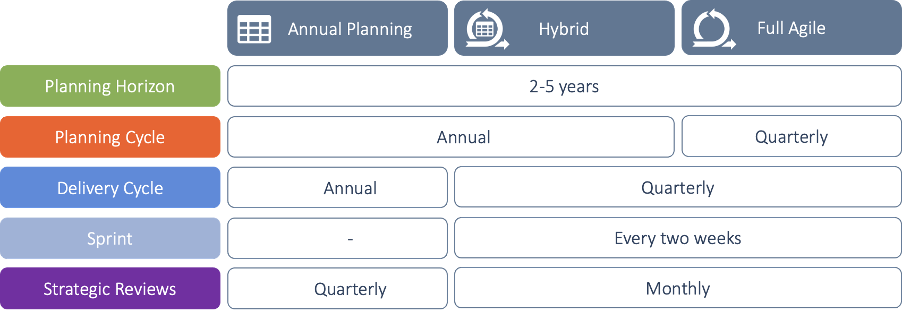
When considering the planning cycle, differences start to appear.
Annual planning is built on an annual planning cycle, and the same is true for the hybrid model.
However, full agile would likely adopt quarterly planning cycles.
Why quarterly? Any longer and responsiveness are compromised. Any shorter and an organization risks introducing the very thing we’re trying to avoid: uncertainty.
Arguably exposing the first key weakness of annual planning, the annual cycle is adopted for both planning and delivery cycles, unlike hybrid and full agile models that adopt unified quarterly delivery cycles.
Annual planning today invariably relies more on traditional project management than agile methods. Once again, both hybrid and full agile models advocate two weekly sprints.
Finally, annual planning might typically hold quarterly strategic reviews.
Here lies another key weakness – not only are these strategic reviews too infrequent, but they also invariably focus on performance against the strategic plan rather than ensuring ongoing relevance of the strategy itself.
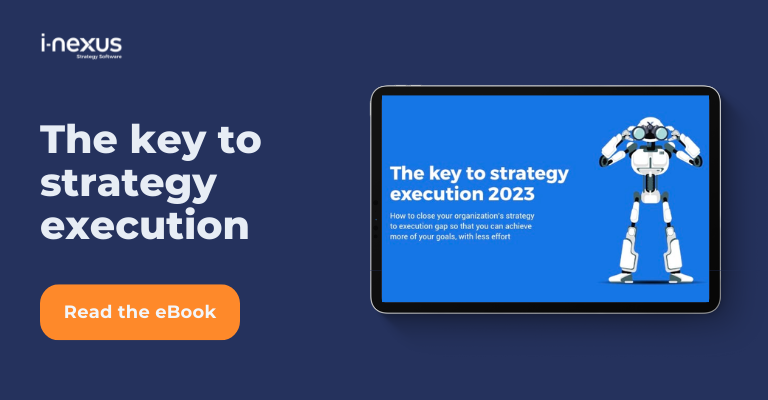
How do you pick the right strategic planning model?
Simple. Your organization cannot afford to continue with traditional strategic planning.
It is simply too rigid and unresponsive.
Nor can organizations afford to pick their strategic direction every quarter, regardless of how well their planning horizon and breakthrough objectives are defined.
The answer is hybrid which leans on both annual planning and full hybrid to emerge with a pragmatic new – and more continuous – approach to strategic planning.
And in a future blog, we’ll explore equally pragmatic steps toward hybrid strategic planning.
Learn more about continuous strategy
Take the next steps in your journey to embracing continuous strategy by exploring our strategy execution resource hub .
About the author
James Davies is i-nexus’ Chief Product Officer. As an experienced software executive with 20 years of experience working in Silicon Valley, USA, James has held senior leadership roles in three venture capital-backed software start-ups (including CEO, CPO, and Chairman). He has delivered management consulting services to some of the world’s largest technology companies. If you’d like to talk more about the future of strategy execution, reach out to him on [email protected] or connect with James on LinkedIn for the latest insights

How Porter's Five Forces supports strategic planning

Why you should use the x matrix strategic planning tool

Top-down vs. bottom-up strategic and operational planning explained

Rational Decision-Making Model: Meaning, Importance And Examples
What is the rational decision-making model? Rational decision-making is a method that organizations, businesses and individuals use to make the…

What is the rational decision-making model? Rational decision-making is a method that organizations, businesses and individuals use to make the best decisions. Rational decision-making, one of many decision-making tools, helps users come up with the most suitable course of action. In this blog, we will look at the meaning of rational decision-making, the importance of rational decision-making and study some rational decision-making examples.
Rational decision-making is a process in which decision-makers go through a set of steps and processes and choose the best solution to a problem. These decisions are based on data analysis and logic, eliminating intuition and subjectivity.
Rational decision-making means that every variable factor, every piece of information about all the available options, has been taken into account.
What Is The Rational Decision-Making Model Used For?
What is the rational decision-making process, non-rational decision making.
The most basic use of the rational decision-making model is to ensure a consistent method of making decisions. This could be used as a standardized decision-making tool across an organization or to ensure that all managers receive the same information to make decisions. The rational decision-making process can be used to maintain a structured, step-by-step approach for every decision.
What Is The Rational Decision-Making Process ?
How the rational decision-making model is implemented can be explained in seven steps:
(There is also an example to help you understand the importance of rational decision-making)
1. Understand and define the scope
Just stating that a problem exists isn’t enough. Solid, accurate data is required to understand and analyze the problem in depth. This lets you know how much attention it requires.
It’s vital to collect as much relevant and accurate data around the problem as possible.
Here’s a rational decision-making example:
Your social media posts aren’t translating to conversions. What could the problem be? Once the analytics reports come in, you realize there isn’t enough engagement. The issue isn’t that your posts are not reaching the right audience, it’s that they don’t engage them. This sets up the next step: figuring out why the problem exists. Why is user engagement low?
2. Research and get feedback
The next step in the rational decision-making process is to delve into the problem. Find out what is causing the problem and how it can be solved. You could start with a brainstorming session and find out what your team thinks.
Rational decision-making example continued:
The budget is good, there are enough views and likes on the posts. So, why is there a lack of engagement? Why aren’t users interacting with the post? Why aren’t they clicking on the CTA?
You might need new types of posts; perhaps the current posts aren’t trendy. Maybe the posts don’t evoke an emotional response from the audience. Or they don’t convey what the product can do for the audience.
Now that you know what the causes could be, you are a step closer. It’s time to collate the data.
The team comes together with their opinions and findings. After a few customer surveys, the major issues are identified as follows:
- Potential consumers don’t know how the product will add value to their lives.
- Potential customers don’t understand the posts’ objectives and aren’t clear on what the product is.
3. List your choices
There are bound to be a host of opinions and innumerable choices about how to address the issue. Consider all of them so that you don’t create more problems later.
This is where you start to use rational decision-making:
Now that the problem has been understood, it’s time to list your options.
You could create a post that showcases what the product does.
You could have an informative GIF that shows that product in action.
You could create additional whitepapers to showcase how the product adds value and thus is beneficial for the customer to buy.
The analytics show that traffic isn’t the issue, so you don’t have to focus on garnering more traffic. Your focus has to be on conversions.
Your color schemes and CTA could be a little more impactful.
Maybe video clips are the way to go?
4. Analyze your options carefully
Now that you have all the options in front of you, cross out the ones that don’t add value or don’t solve the problem. Understand how each of the potential solutions could turn out and what other effects they could have.
Point 6 is about having a back up plan. Once you’ve chosen the plan that is likely to serve you the best, choose the second best option as well. You could use that as your back up, in case things don’t go according to plan.
While it’s great to get a quick solution to a real problem, the solution should be permanent or at least solve the majority of the issue.
The example of the rational decision-making process continued:
This is where you set about deciding the benefits of each of your choices mentioned above.
A video clip post would mean additional costs.
Redesigning the graphics may lead to more views and interaction but dilute your following.
A whitepaper is a good idea, but it doesn’t help with conversions. It’s ideal for customers to click on the CTA.
While GIFs are very popular, the image you choose has to convey the right information and be impactful. You may need to rework the branding for this to work.
While it would be great to have a post that showcases how the product works, it can’t be overly technical.
5. Understand the results you want
This is where the importance of rational decision-making comes into play. Understand what you expect from the solutions. There has to be a clear outcome because of the decision that is made. Knowing what you expect from your actions is important. It’s always a good idea to test the solution to see if it resolves the problem entirely.
Rational decision-making model example continued:
The best course of action might be to assign different teams for the different potential solutions.
One team could create a GIF, while the other works on the video clip and another on the ‘how to use’ post.
Once the teams have all made rough drafts, a productive critiquing session could be conducted. The teams can then look at each others’ solutions and point out the merits and drawbacks of each.
This way a general consensus can be reached and the best option or options can be selected. It is also advisable to use predictive social media tools. There are algorithms and equations that could help predict the success of a post to some degree.
6. Have a backup plan
While this may not always be necessary and can be a little cost-intensive, it may be worthwhile to have a backup plan if the solution doesn’t give you the intended results. This means that you should either have another strategy in place, created using the rational decision-making model .
Even though your plan has been made after careful thought, there is a chance that it either does not go as per plan or that an external factor interferes and throws your plan into chaos.
Try to have a back-up plan to make sure that your business isn’t impacted.
Now that you’ve decided to go with a combination of a GIF and an information-based post, go ahead and begin drafting your white paper as well.
7. Implement
Once the team has done all the work and created the solution, implement it. Implementing this plan means that everyone has to be on board. This means that everyone should be informed and be willing to contribute in executing the plan. The plan won’t work if everyone isn’t working toward the same goal.
As logic and data have been used to reach the decision, it’s likely going to be the most effective one.
Non -Rational Decision-Making
Non-rational decision-making is quite simply the opposite of rational decision-making . Non-rational decision-making is generally used when there isn’t enough information available or when there isn’t enough time to carry out the research and analysis required to employ rational decision-making methods.
Non-rational decision-making can be used when the person or team making the decisions has experienced that issue before or their collective experience allows them to predict what the outcome of their decision would be.
To sum it up, rational decision making can be the difference between a high performance culture driven by results and an unorganized setting. If you would like to drive decisions that guarantee results, you have to employ strategies that kindle organizational objectives based on real data. Let’s sum up the steps explained in this post about the importance of rational decision-making.
- Understand and define the scope
- Research and get feedback
- List your choices
- Analyze your options carefully
- Understand the results you want
Now that you have some idea of what the rational decision-making process is, you may be curious to find out how to make better decisions for your business. To understand more about the importance of rational decision-making , take a look at Harappa’s Making Decisions course. It delves deep into how the best decisions can be reached. The course is for you if you’re looking to get into business and learn how to use rational decision-making.
Explore Harappa Diaries to learn more about topics such as How To Define Problem , Steps involved in Ethical Decision Making , Importance Of Decision Making and How To Overcome Indecisiveness to classify problems and solve them efficiently.

Rational Decision Making: The 7-Step Process for Making Logical Decisions
Published: October 17, 2023
Psychology tells us that emotions drive our behavior, while logic only justifies our actions after the fact . Marketing confirms this theory. Humans associate the same personality traits with brands as they do with people — choosing your favorite brand is like choosing your best friend or significant other. We go with the option that makes us feel something.

But emotions can cloud your reasoning, especially when you need to do something that could cause internal pain, like giving constructive criticism, or moving on from something you’re attached to, like scrapping a favorite topic from your team's content calendar.
![business planning rational model Download Now: How to Be More Productive at Work [Free Guide + Templates]](https://no-cache.hubspot.com/cta/default/53/be08853d-7ccb-4ab6-ba13-ef66a1d9b4ff.png)
There’s a way to suppress this emotional bias, though. It’s a thought process that’s completely objective and data-driven. It's called the rational decision making model, and it will help you make logically sound decisions even in situations with major ramifications , like pivoting your entire blogging strategy.
But before we learn each step of this powerful process, let’s go over what exactly rational decision making is and why it’s important.
What is Rational Decision Making?
Rational decision making is a problem-solving methodology that factors in objectivity and logic instead of subjectivity and intuition to achieve a goal. The goal of rational decision making is to identify a problem, pick a solution between multiple alternatives, and find an answer.
Rational decision making is an important skill to possess, especially in the digital marketing industry. Humans are inherently emotional, so our biases and beliefs can blur our perception of reality. Fortunately, data sharpens our view. By showing us how our audience actually interacts with our brand, data liberates us from relying on our assumptions to determine what our audience likes about us.
Rational Decision Making Model: 7 Easy Steps(+ Examples)
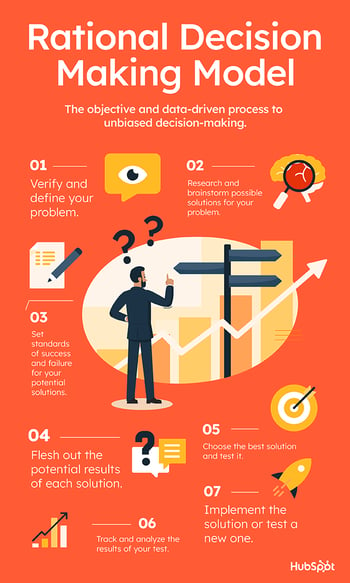
1. Verify and define your problem.
To prove that you actually have a problem, you need evidence for it. Most marketers think data is the silver bullet that can diagnose any issue in our strategy, but you actually need to extract insights from your data to prove anything. If you don’t, you’re just looking at a bunch of numbers packed into a spreadsheet.
To pinpoint your specific problem, collect as much data from your area of need and analyze it to find any alarming patterns or trends.
“After analyzing our blog traffic report, we now know why our traffic has plateaued for the past year — our organic traffic increases slightly month over month but our email and social traffic decrease.”
2. Research and brainstorm possible solutions for your problem.
Expanding your pool of potential solutions boosts your chances of solving your problem. To find as many potential solutions as possible, you should gather plenty of information about your problem from your own knowledge and the internet. You can also brainstorm with others to uncover more possible solutions.
Potential Solution 1: “We could focus on growing organic, email, and social traffic all at the same time."
Potential Solution 2: “We could focus on growing email and social traffic at the same time — organic traffic already increases month over month while traffic from email and social decrease.”
Potential Solution 3: "We could solely focus on growing social traffic — growing social traffic is easier than growing email and organic traffic at the same time. We also have 2 million followers on Facebook, so we could push our posts to a ton of readers."
Potential Solution 4: "We could solely focus on growing email traffic — growing email traffic is easier than growing social and organic traffic at the same time. We also have 250,000 blog subscribers, so we could push our posts to a ton of readers."
Potential Solution 5: "We could solely focus on growing organic traffic — growing organic traffic is easier than growing social and email traffic at the same time. We also just implemented a pillar-cluster model to boost our domain’s authority, so we could attract a ton of readers from Google."
3. Set standards of success and failure for your potential solutions.
Setting a threshold to measure your solutions' success and failure lets you determine which ones can actually solve your problem. Your standard of success shouldn’t be too high, though. You’d never be able to find a solution. But if your standards are realistic, quantifiable, and focused, you’ll be able to find one.
“If one of our solutions increases our total traffic by 10%, we should consider it a practical way to overcome our traffic plateau.”
4. Flesh out the potential results of each solution.
Next, you should determine each of your solutions’ consequences. To do so, create a strength and weaknesses table for each alternative and compare them to each other. You should also prioritize your solutions in a list from best chance to solve the problem to worst chance.
Potential Result 1: ‘Growing organic, email, and social traffic at the same time could pay a lot of dividends, but our team doesn’t have enough time or resources to optimize all three channels.”
Potential Result 2: “Growing email and social traffic at the same time would marginally increase overall traffic — both channels only account for 20% of our total traffic."
Potential Result 3: “Growing social traffic by posting a blog post everyday on Facebook is challenging because the platform doesn’t elevate links in the news feed and the channel only accounts for 5% of our blog traffic. Focusing solely on social would produce minimal results.”
Potential Result 4: “Growing email traffic by sending two emails per day to our blog subscribers is challenging because we already send one email to subscribers everyday and the channel only accounts for 15% of our blog traffic. Focusing on email would produce minimal results.”
Potential Result 5: “Growing organic traffic by targeting high search volume keywords for all of our new posts is the easiest way to grow our blog’s overall traffic. We have a high domain authority, Google refers 80% of our total traffic, and we just implemented a pillar-cluster model. Focusing on organic would produce the most results.”
5. Choose the best solution and test it.
Based on the evaluation of your potential solutions, choose the best one and test it. You can start monitoring your preliminary results during this stage too.
“Focusing on organic traffic seems to be the most effective and realistic play for us. Let’s test an organic-only strategy where we only create new content that has current or potential search volume and fits into our pillar cluster model.”
6. Track and analyze the results of your test.
Track and analyze your results to see if your solution actually solved your problem.
“After a month of testing, our blog traffic has increased by 14% and our organic traffic has increased by 21%.”
7. Implement the solution or test a new one.
If your potential solution passed your test and solved your problem, then it’s the most rational decision you can make. You should implement it to completely solve your current problem or any other related problems in the future. If the solution didn’t solve your problem, then test another potential solution that you came up with.
“The results from solely focusing on organic surpassed our threshold of success. From now on, we’re pivoting to an organic-only strategy, where we’ll only create new blog content that has current or future search volume and fits into our pillar cluster model.”
Avoid Bias With A Rational Decision Making Process
As humans, it’s natural for our emotions to take over your decision making process. And that’s okay. Sometimes, emotional decisions are better than logical ones. But when you really need to prioritize logic over emotion, arming your mind with the rational decision making model can help you suppress your emotion bias and be as objective as possible.

Don't forget to share this post!
Related articles.


Decision Trees: A Simple Tool to Make Radically Better Decisions

Mental Models: The Ultimate Guide

The Ultimate Guide to Decision Making
![business planning rational model How Product Packaging Influences Buying Decisions [Infographic]](https://blog.hubspot.com/hs-fs/hub/53/file-2411322621-png/00-Blog_Thinkstock_Images/product-packaging.png)
How Product Packaging Influences Buying Decisions [Infographic]

The Five Stages of the Consumer Decision-Making Process Explained
Outline your company's marketing strategy in one simple, coherent plan.
Marketing software that helps you drive revenue, save time and resources, and measure and optimize your investments — all on one easy-to-use platform
- Product overview
- All features
- App integrations
CAPABILITIES
- project icon Project management
- Project views
- Custom fields
- Status updates
- goal icon Goals and reporting
- Reporting dashboards
- workflow icon Workflows and automation
- portfolio icon Resource management
- Time tracking
- my-task icon Admin and security
- Admin console
- asana-intelligence icon Asana Intelligence
- list icon Personal
- premium icon Starter
- briefcase icon Advanced
- Goal management
- Organizational planning
- Campaign management
- Creative production
- Marketing strategic planning
- Request tracking
- Resource planning
- Project intake
- View all uses arrow-right icon
- Project plans
- Team goals & objectives
- Team continuity
- Meeting agenda
- View all templates arrow-right icon
- Work management resources Discover best practices, watch webinars, get insights
- What's new Learn about the latest and greatest from Asana
- Customer stories See how the world's best organizations drive work innovation with Asana
- Help Center Get lots of tips, tricks, and advice to get the most from Asana
- Asana Academy Sign up for interactive courses and webinars to learn Asana
- Developers Learn more about building apps on the Asana platform
- Community programs Connect with and learn from Asana customers around the world
- Events Find out about upcoming events near you
- Partners Learn more about our partner programs
- Support Need help? Contact the Asana support team
- Asana for nonprofits Get more information on our nonprofit discount program, and apply.
Featured Reads

- Business strategy |
- 7 strategic planning models, plus 8 fra ...
7 strategic planning models, plus 8 frameworks to help you get started
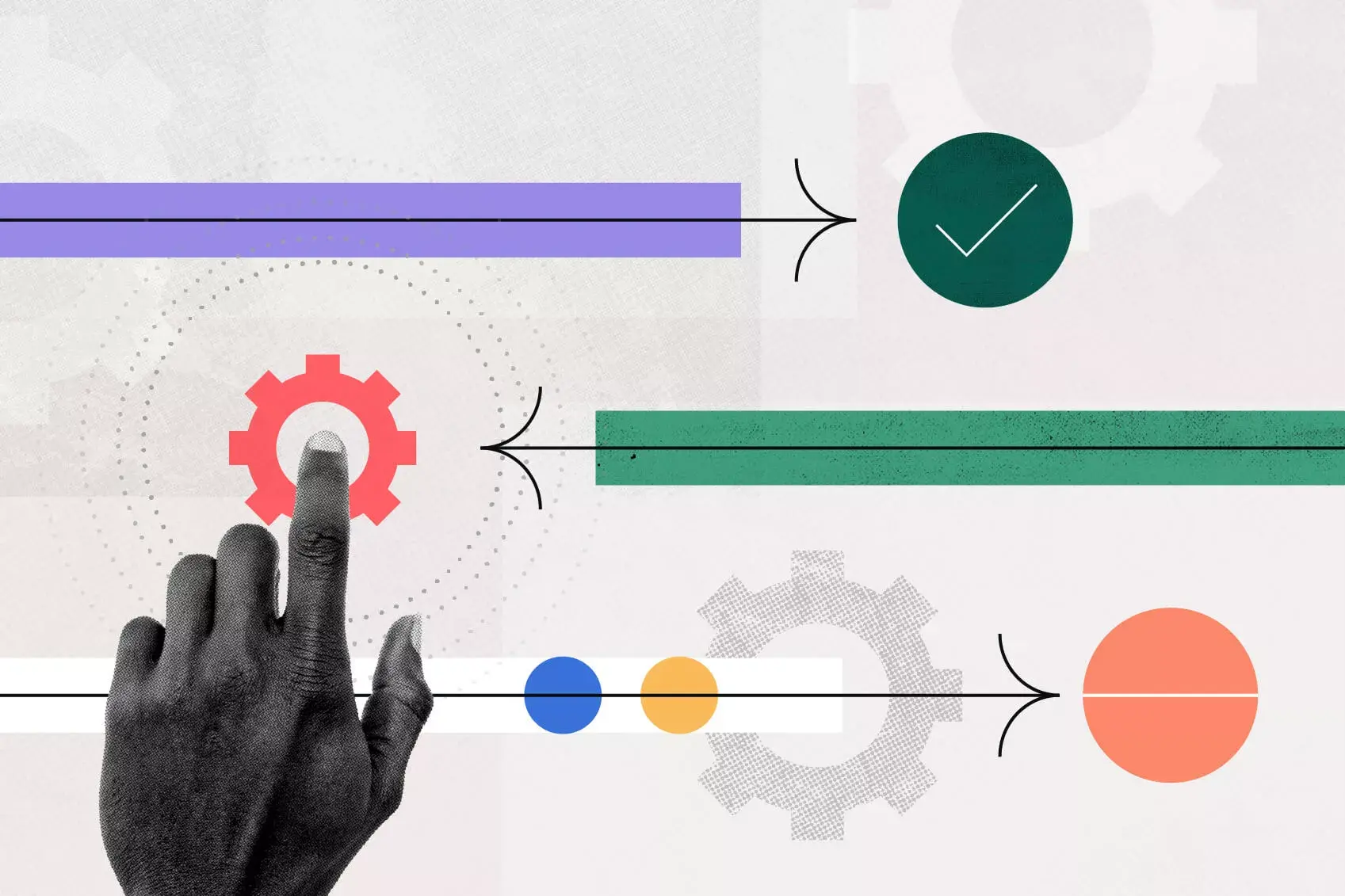
Strategic planning is vital in defining where your business is going in the next three to five years. With the right strategic planning models and frameworks, you can uncover opportunities, identify risks, and create a strategic plan to fuel your organization’s success. We list the most popular models and frameworks and explain how you can combine them to create a strategic plan that fits your business.
A strategic plan is a great tool to help you hit your business goals . But sometimes, this tool needs to be updated to reflect new business priorities or changing market conditions. If you decide to use a model that already exists, you can benefit from a roadmap that’s already created. The model you choose can improve your knowledge of what works best in your organization, uncover unknown strengths and weaknesses, or help you find out how you can outpace your competitors.
In this article, we cover the most common strategic planning models and frameworks and explain when to use which one. Plus, get tips on how to apply them and which models and frameworks work well together.
Strategic planning models vs. frameworks
First off: This is not a one-or-nothing scenario. You can use as many or as few strategic planning models and frameworks as you like.
When your organization undergoes a strategic planning phase, you should first pick a model or two that you want to apply. This will provide you with a basic outline of the steps to take during the strategic planning process.
![business planning rational model [Inline illustration] Strategic planning models vs. frameworks (Infographic)](https://assets.asana.biz/transform/89236d14-1abf-4f49-8b91-4187147f1c63/inline-business-strategy-strategic-planning-models-1-2x?io=transform:fill,width:2560&format=webp)
During that process, think of strategic planning frameworks as the tools in your toolbox. Many models suggest starting with a SWOT analysis or defining your vision and mission statements first. Depending on your goals, though, you may want to apply several different frameworks throughout the strategic planning process.
For example, if you’re applying a scenario-based strategic plan, you could start with a SWOT and PEST(LE) analysis to get a better overview of your current standing. If one of the weaknesses you identify has to do with your manufacturing process, you could apply the theory of constraints to improve bottlenecks and mitigate risks.
Now that you know the difference between the two, learn more about the seven strategic planning models, as well as the eight most commonly used frameworks that go along with them.
![business planning rational model [Inline illustration] The seven strategic planning models (Infographic)](https://assets.asana.biz/transform/23048ae4-8a18-4b9b-ad9e-33b0fc5d04ee/inline-business-strategy-strategic-planning-models-2-2x?io=transform:fill,width:2560&format=webp)
1. Basic model
The basic strategic planning model is ideal for establishing your company’s vision, mission, business objectives, and values. This model helps you outline the specific steps you need to take to reach your goals, monitor progress to keep everyone on target, and address issues as they arise.
If it’s your first strategic planning session, the basic model is the way to go. Later on, you can embellish it with other models to adjust or rewrite your business strategy as needed. Let’s take a look at what kinds of businesses can benefit from this strategic planning model and how to apply it.
Small businesses or organizations
Companies with little to no strategic planning experience
Organizations with few resources
Write your mission statement. Gather your planning team and have a brainstorming session. The more ideas you can collect early in this step, the more fun and rewarding the analysis phase will feel.
Identify your organization’s goals . Setting clear business goals will increase your team’s performance and positively impact their motivation.
Outline strategies that will help you reach your goals. Ask yourself what steps you have to take in order to reach these goals and break them down into long-term, mid-term, and short-term goals .
Create action plans to implement each of the strategies above. Action plans will keep teams motivated and your organization on target.
Monitor and revise the plan as you go . As with any strategic plan, it’s important to closely monitor if your company is implementing it successfully and how you can adjust it for a better outcome.
2. Issue-based model
Also called goal-based planning model, this is essentially an extension of the basic strategic planning model. It’s a bit more dynamic and very popular for companies that want to create a more comprehensive plan.
Organizations with basic strategic planning experience
Businesses that are looking for a more comprehensive plan
Conduct a SWOT analysis . Assess your organization’s strengths, weaknesses, opportunities, and threats with a SWOT analysis to get a better overview of what your strategic plan should focus on. We’ll give into how to conduct a SWOT analysis when we get into the strategic planning frameworks below.
Identify and prioritize major issues and/or goals. Based on your SWOT analysis, identify and prioritize what your strategic plan should focus on this time around.
Develop your main strategies that address these issues and/or goals. Aim to develop one overarching strategy that addresses your highest-priority goal and/or issue to keep this process as simple as possible.
Update or create a mission and vision statement . Make sure that your business’s statements align with your new or updated strategy. If you haven’t already, this is also a chance for you to define your organization’s values.
Create action plans. These will help you address your organization’s goals, resource needs, roles, and responsibilities.
Develop a yearly operational plan document. This model works best if your business repeats the strategic plan implementation process on an annual basis, so use a yearly operational plan to capture your goals, progress, and opportunities for next time.
Allocate resources for your year-one operational plan. Whether you need funding or dedicated team members to implement your first strategic plan, now is the time to allocate all the resources you’ll need.
Monitor and revise the strategic plan. Record your lessons learned in the operational plan so you can revisit and improve it for the next strategic planning phase.
The issue-based plan can repeat on an annual basis (or less often once you resolve the issues). It’s important to update the plan every time it’s in action to ensure it’s still doing the best it can for your organization.
You don’t have to repeat the full process every year—rather, focus on what’s a priority during this run.
3. Alignment model
This model is also called strategic alignment model (SAM) and is one of the most popular strategic planning models. It helps you align your business and IT strategies with your organization’s strategic goals.
You’ll have to consider four equally important, yet different perspectives when applying the alignment strategic planning model:
Strategy execution: The business strategy driving the model
Technology potential: The IT strategy supporting the business strategy
Competitive potential: Emerging IT capabilities that can create new products and services
Service level: Team members dedicated to creating the best IT system in the organization
Ideally, your strategy will check off all the criteria above—however, it’s more likely you’ll have to find a compromise.
Here’s how to create a strategic plan using the alignment model and what kinds of companies can benefit from it.
Organizations that need to fine-tune their strategies
Businesses that want to uncover issues that prevent them from aligning with their mission
Companies that want to reassess objectives or correct problem areas that prevent them from growing
Outline your organization’s mission, programs, resources, and where support is needed. Before you can improve your statements and approaches, you need to define what exactly they are.
Identify what internal processes are working and which ones aren’t. Pinpoint which processes are causing problems, creating bottlenecks , or could otherwise use improving. Then prioritize which internal processes will have the biggest positive impact on your business.
Identify solutions. Work with the respective teams when you’re creating a new strategy to benefit from their experience and perspective on the current situation.
Update your strategic plan with the solutions. Update your strategic plan and monitor if implementing it is setting your business up for improvement or growth. If not, you may have to return to the drawing board and update your strategic plan with new solutions.
4. Scenario model
The scenario model works great if you combine it with other models like the basic or issue-based model. This model is particularly helpful if you need to consider external factors as well. These can be government regulations, technical, or demographic changes that may impact your business.
Organizations trying to identify strategic issues and goals caused by external factors
Identify external factors that influence your organization. For example, you should consider demographic, regulation, or environmental factors.
Review the worst case scenario the above factors could have on your organization. If you know what the worst case scenario for your business looks like, it’ll be much easier to prepare for it. Besides, it’ll take some of the pressure and surprise out of the mix, should a scenario similar to the one you create actually occur.
Identify and discuss two additional hypothetical organizational scenarios. On top of your worst case scenario, you’ll also want to define the best case and average case scenarios. Keep in mind that the worst case scenario from the previous step can often provoke strong motivation to change your organization for the better. However, discussing the other two will allow you to focus on the positive—the opportunities your business may have ahead.
Identify and suggest potential strategies or solutions. Everyone on the team should now brainstorm different ways your business could potentially respond to each of the three scenarios. Discuss the proposed strategies as a team afterward.
Uncover common considerations or strategies for your organization. There’s a good chance that your teammates come up with similar solutions. Decide which ones you like best as a team or create a new one together.
Identify the most likely scenario and the most reasonable strategy. Finally, examine which of the three scenarios is most likely to occur in the next three to five years and how your business should respond to potential changes.
5. Self-organizing model
Also called the organic planning model, the self-organizing model is a bit different from the linear approaches of the other models. You’ll have to be very patient with this method.
This strategic planning model is all about focusing on the learning and growing process rather than achieving a specific goal. Since the organic model concentrates on continuous improvement , the process is never really over.
Large organizations that can afford to take their time
Businesses that prefer a more naturalistic, organic planning approach that revolves around common values, communication, and shared reflection
Companies that have a clear understanding of their vision
Define and communicate your organization’s cultural values . Your team can only think clearly and with solutions in mind when they have a clear understanding of your organization's values.
Communicate the planning group’s vision for the organization. Define and communicate the vision with everyone involved in the strategic planning process. This will align everyone’s ideas with your company’s vision.
Discuss what processes will help realize the organization’s vision on a regular basis. Meet every quarter to discuss strategies or tactics that will move your organization closer to realizing your vision.
6. Real-time model
This fluid model can help organizations that deal with rapid changes to their work environment. There are three levels of success in the real-time model:
Organizational: At the organizational level, you’re forming strategies in response to opportunities or trends.
Programmatic: At the programmatic level, you have to decide how to respond to specific outcomes or environmental changes.
Operational: On the operational level, you will study internal systems, policies, and people to develop a strategy for your company.
Figuring out your competitive advantage can be difficult, but this is absolutely crucial to ensure success. Whether it’s a unique asset or strength your organization has or an outstanding execution of services or programs—it’s important that you can set yourself apart from others in the industry to succeed.
Companies that need to react quickly to changing environments
Businesses that are seeking new tools to help them align with their organizational strategy
Define your mission and vision statement. If you ever feel stuck formulating your company’s mission or vision statement, take a look at those of others. Maybe Asana’s vision statement sparks some inspiration.
Research, understand, and learn from competitor strategy and market trends. Pick a handful of competitors in your industry and find out how they’ve created success for themselves. How did they handle setbacks or challenges? What kinds of challenges did they even encounter? Are these common scenarios in the market? Learn from your competitors by finding out as much as you can about them.
Study external environments. At this point, you can combine the real-time model with the scenario model to find solutions to threats and opportunities outside of your control.
Conduct a SWOT analysis of your internal processes, systems, and resources. Besides the external factors your team has to consider, it’s also important to look at your company’s internal environment and how well you’re prepared for different scenarios.
Develop a strategy. Discuss the results of your SWOT analysis to develop a business strategy that builds toward organizational, programmatic, and operational success.
Rinse and repeat. Monitor how well the new strategy is working for your organization and repeat the planning process as needed to ensure you’re on top or, perhaps, ahead of the game.
7. Inspirational model
This last strategic planning model is perfect to inspire and energize your team as they work toward your organization’s goals. It’s also a great way to introduce or reconnect your employees to your business strategy after a merger or acquisition.
Businesses with a dynamic and inspired start-up culture
Organizations looking for inspiration to reinvigorate the creative process
Companies looking for quick solutions and strategy shifts
Gather your team to discuss an inspirational vision for your organization. The more people you can gather for this process, the more input you will receive.
Brainstorm big, hairy audacious goals and ideas. Encouraging your team not to hold back with ideas that may seem ridiculous will do two things: for one, it will mitigate the fear of contributing bad ideas. But more importantly, it may lead to a genius idea or suggestion that your team wouldn’t have thought of if they felt like they had to think inside of the box.
Assess your organization’s resources. Find out if your company has the resources to implement your new ideas. If they don’t, you’ll have to either adjust your strategy or allocate more resources.
Develop a strategy balancing your resources and brainstorming ideas. Far-fetched ideas can grow into amazing opportunities but they can also bear great risk. Make sure to balance ideas with your strategic direction.
Now, let’s dive into the most commonly used strategic frameworks.
8. SWOT analysis framework
One of the most popular strategic planning frameworks is the SWOT analysis . A SWOT analysis is a great first step in identifying areas of opportunity and risk—which can help you create a strategic plan that accounts for growth and prepares for threats.
SWOT stands for strengths, weaknesses, opportunities, and threats. Here’s an example:
![business planning rational model [Inline illustration] SWOT analysis (Example)](https://assets.asana.biz/transform/cfab4ed2-46d1-4636-b801-14b3d86c8367/inline-project-management-SWOT-analysis-4-2x?io=transform:fill,width:2560&format=webp)
9. OKRs framework
A big part of strategic planning is setting goals for your company. That’s where OKRs come into play.
OKRs stand for objective and key results—this goal-setting framework helps your organization set and achieve goals. It provides a somewhat holistic approach that you can use to connect your team’s work to your organization’s big-picture goals. When team members understand how their individual work contributes to the organization’s success, they tend to be more motivated and produce better results
10. Balanced scorecard (BSC) framework
The balanced scorecard is a popular strategic framework for businesses that want to take a more holistic approach rather than just focus on their financial performance. It was designed by David Norton and Robert Kaplan in the 1990s, it’s used by companies around the globe to:
Communicate goals
Align their team’s daily work with their company’s strategy
Prioritize products, services, and projects
Monitor their progress toward their strategic goals
Your balanced scorecard will outline four main business perspectives:
Customers or clients , meaning their value, satisfaction, and/or retention
Financial , meaning your effectiveness in using resources and your financial performance
Internal process , meaning your business’s quality and efficiency
Organizational capacity , meaning your organizational culture, infrastructure and technology, and human resources
With the help of a strategy map, you can visualize and communicate how your company is creating value. A strategy map is a simple graphic that shows cause-and-effect connections between strategic objectives.
The balanced scorecard framework is an amazing tool to use from outlining your mission, vision, and values all the way to implementing your strategic plan .
You can use an integration like Lucidchart to create strategy maps for your business in Asana.
11. Porter’s Five Forces framework
If you’re using the real-time strategic planning model, Porter’s Five Forces are a great framework to apply. You can use it to find out what your product’s or service’s competitive advantage is before entering the market.
Developed by Michael E. Porter , the framework outlines five forces you have to be aware of and monitor:
![business planning rational model [Inline illustration] Porter’s Five Forces framework (Infographic)](https://assets.asana.biz/transform/d63265bc-23e2-4ce6-9b91-b3da5a756619/inline-business-strategy-strategic-planning-models-3-2x?io=transform:fill,width:2560&format=webp)
Threat of new industry entrants: Any new entry into the market results in increased pressure on prices and costs.
Competition in the industry: The more competitors that exist, the more difficult it will be for you to create value in the market with your product or service.
Bargaining power of suppliers: Suppliers can wield more power if there are less alternatives for buyers or it’s expensive, time consuming, or difficult to switch to a different supplier.
Bargaining power of buyers: Buyers can wield more power if the same product or service is available elsewhere with little to no difference in quality.
Threat of substitutes: If another company already covers the market’s needs, you’ll have to create a better product or service or make it available for a lower price at the same quality in order to compete.
Remember, industry structures aren’t static. The more dynamic your strategic plan is, the better you’ll be able to compete in a market.
12. VRIO framework
The VRIO framework is another strategic planning tool designed to help you evaluate your competitive advantage. VRIO stands for value, rarity, imitability, and organization.
It’s a resource-based theory developed by Jay Barney. With this framework, you can study your firmed resources and find out whether or not your company can transform them into sustained competitive advantages.
Firmed resources can be tangible (e.g., cash, tools, inventory, etc.) or intangible (e.g., copyrights, trademarks, organizational culture, etc.). Whether these resources will actually help your business once you enter the market depends on four qualities:
Valuable : Will this resource either increase your revenue or decrease your costs and thereby create value for your business?
Rare : Are the resources you’re using rare or can others use your resources as well and therefore easily provide the same product or service?
Inimitable : Are your resources either inimitable or non-substitutable? In other words, how unique and complex are your resources?
Organizational: Are you organized enough to use your resources in a way that captures their value, rarity, and inimitability?
It’s important that your resources check all the boxes above so you can ensure that you have sustained competitive advantage over others in the industry.
13. Theory of Constraints (TOC) framework
If the reason you’re currently in a strategic planning process is because you’re trying to mitigate risks or uncover issues that could hurt your business—this framework should be in your toolkit.
The theory of constraints (TOC) is a problem-solving framework that can help you identify limiting factors or bottlenecks preventing your organization from hitting OKRs or KPIs .
Whether it’s a policy, market, or recourse constraint—you can apply the theory of constraints to solve potential problems, respond to issues, and empower your team to improve their work with the resources they have.
14. PEST/PESTLE analysis framework
The idea of the PEST analysis is similar to that of the SWOT analysis except that you’re focusing on external factors and solutions. It’s a great framework to combine with the scenario-based strategic planning model as it helps you define external factors connected to your business’s success.
PEST stands for political, economic, sociological, and technological factors. Depending on your business model, you may want to expand this framework to include legal and environmental factors as well (PESTLE). These are the most common factors you can include in a PESTLE analysis:
Political: Taxes, trade tariffs, conflicts
Economic: Interest and inflation rate, economic growth patterns, unemployment rate
Social: Demographics, education, media, health
Technological: Communication, information technology, research and development, patents
Legal: Regulatory bodies, environmental regulations, consumer protection
Environmental: Climate, geographical location, environmental offsets
15. Hoshin Kanri framework
Hoshin Kanri is a great tool to communicate and implement strategic goals. It’s a planning system that involves the entire organization in the strategic planning process. The term is Japanese and stands for “compass management” and is also known as policy management.
This strategic planning framework is a top-down approach that starts with your leadership team defining long-term goals which are then aligned and communicated with every team member in the company.
You should hold regular meetings to monitor progress and update the timeline to ensure that every teammate’s contributions are aligned with the overarching company goals.
Stick to your strategic goals
Whether you’re a small business just starting out or a nonprofit organization with decades of experience, strategic planning is a crucial step in your journey to success.
If you’re looking for a tool that can help you and your team define, organize, and implement your strategic goals, Asana is here to help. Our goal-setting software allows you to connect all of your team members in one place, visualize progress, and stay on target.
Related resources

Grant management: A nonprofit’s guide

How Asana uses work management for organizational planning

How Asana uses work management to optimize resource planning

Solve your tech overload with an intelligent transformation
Comprehensive Model of Decision-Making
- Reference work entry
- First Online: 01 January 2018
- pp 999–1002
- Cite this reference work entry

- Renee Prunty 2
366 Accesses
Rational-comprehensive decision-making; Rational-comprehensive model; Rational decision-making model; Rational planning model
The costs and benefits of every possible solution to a problem are considered, and the solution with the greatest benefit is selected.
Introduction
How public administrators make decisions for public agencies is a concept that is much debated. There is a lot of discussion over the decision-makers themselves, but even more about how these decision-makers determine the best or optimal decision. This is particularly important in public administration where the effects of decisions can have a broad array of repercussions for the public. Accordingly, the public will want to know that the public administrators are selecting the best alternative. Often for the public, this means understanding how the agency arrived at the conclusion that the most favorable decision was achieved. They are also likely to analyze whether or not they agree with the...
This is a preview of subscription content, log in via an institution to check access.
Access this chapter
- Available as PDF
- Read on any device
- Instant download
- Own it forever
- Available as EPUB and PDF
Tax calculation will be finalised at checkout
Purchases are for personal use only
Institutional subscriptions
Eisenhardt KM (1989) Making fast strategic decisions in high-velocity environments. Academy of Management Journal 32(3):543–576
Google Scholar
Forester J (1984) Bounded rationality and the politics of muddling through. Public Administration Review 44(1):23–31
Article Google Scholar
Lindblom CE (1959) The science of “muddling through”. Public Administration Review:79–88
Svenson O (1979) Process descriptions of decision making. Organizational Behavior and Human Performance 23(1):86–112
Download references
Author information
Authors and affiliations.
Methodist College, Peoria, IL, USA
Renee Prunty
You can also search for this author in PubMed Google Scholar
Corresponding author
Correspondence to Renee Prunty .
Editor information
Editors and affiliations.
Florida Atlantic University, Boca Raton, FL, USA
Ali Farazmand
Rights and permissions
Reprints and permissions
Copyright information
© 2018 Springer International Publishing AG, part of Springer Nature
About this entry
Cite this entry.
Prunty, R. (2018). Comprehensive Model of Decision-Making. In: Farazmand, A. (eds) Global Encyclopedia of Public Administration, Public Policy, and Governance. Springer, Cham. https://doi.org/10.1007/978-3-319-20928-9_25
Download citation
DOI : https://doi.org/10.1007/978-3-319-20928-9_25
Published : 16 June 2018
Publisher Name : Springer, Cham
Print ISBN : 978-3-319-20927-2
Online ISBN : 978-3-319-20928-9
eBook Packages : Economics and Finance Reference Module Humanities and Social Sciences Reference Module Business, Economics and Social Sciences
Share this entry
Anyone you share the following link with will be able to read this content:
Sorry, a shareable link is not currently available for this article.
Provided by the Springer Nature SharedIt content-sharing initiative
- Publish with us
Policies and ethics
- Find a journal
- Track your research

How it works
For Business
Join Mind Tools
Article • 9 min read
The Business Motivation Model
Preparing a resilient business plan.
By the Mind Tools Content Team

Have you ever had to develop a business plan for your organization or for a new business?
If you have, then you know how difficult it can be to get it right. There are many different elements to consider, and it can be easy to overlook factors that may have a positive or negative effect on your success.
This is where it can be helpful to use the Business Motivation Model. This tool offers a practical way of sense-checking and optimizing your plan. By using it, you can develop a resilient business plan – one where you've explored the impact of internal and external influencers, and have adjusted the plan appropriately.
In this article, we'll look at what the Business Motivation Model is, and we'll explore how you can use it to improve business planning.
About the Model
The Business Motivation Model was originally developed by the Business Rules Group, a non-commercial consulting firm, in the late 1990s. Its goal was to help people prepare business plans in an ordered, efficient, properly-organized way.
Put simply, the Business Motivation Model helps you think about why you're creating a business plan, identify the essential elements that you need to include, and understand how all of these factors interact with one another. This helps you ensure that your business plan is robust and internally consistent, that it fairly explores the impact of the plan, and that it takes your business in a direction that is useful and valuable.
The model is not only useful for writing traditional business plans – you can also use it to plan projects and new processes.
The name of this model, "The Business Motivation Model," is not particularly helpful. Don't worry too much about this.
There are four main elements to the model:
- Ends: This is what you want to accomplish with your plan. "Ends" consist of a Vision, Goals, and Objectives. (These are defined in a slightly differently way from the vision, goals, and objectives that we describe elsewhere within Mind Tools – more on this later!)
- Means: These describe how you're going to achieve the Ends. They include your mission, your overall strategy, and the organizational policies and rules that will affect the achievement of your Ends.
- Influencers: This is where you assess the people or things, inside or outside your organization, that can affect your Ends or Means.
- Assessment: This is where you assess your Influencers, and then review and adjust your Ends and Means as necessary.
As you can see in figure 1, below, the model isn't linear – once you've analyzed and assessed Influencers, you review your Ends and Means, and update them until all elements are consistent and well-aligned.
Figure 1 – The Business Motivation Model
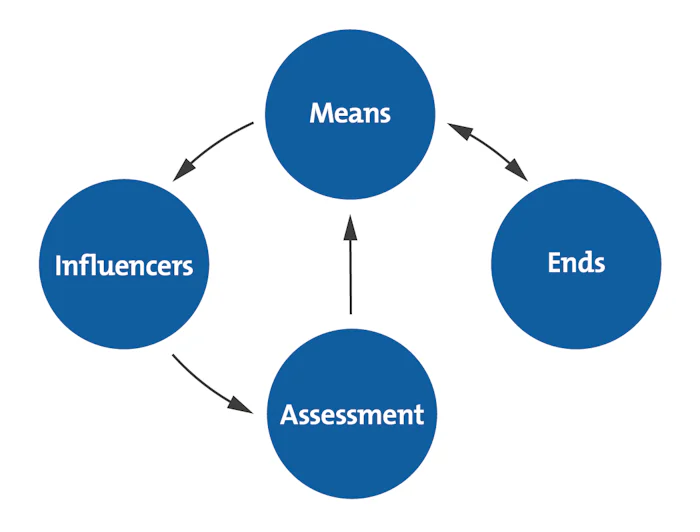
We'll now look into each element in more detail.
This is where you identify your final, desired result. You can start at this stage, but you'll probably find it more effective to work on your Ends and Means at the same time.
Begin by writing a vision statement . This is a human- or idea-centered statement that expresses what the organization wants to do or become in the long-term. Our article on Mission Statements and Vision Statements explores how to create powerful vision statements.
In this model, creating a mission statement comes under the Means, but it's often more effective to create mission and vision statements at the same time.
Goals and Objectives
You then need to set the Goals and Objectives that will help you achieve your vision.
In the Business Motivation Model, a Goal is long-term, qualitative (rather than quantitative), general (rather than specific), and ongoing. For example, "Answer telephone calls more quickly," or "Offer a friendly service to customers."
You must continually satisfy your goals in order to reach your Vision.
Objectives, on the other hand, need to be attainable , measurable , and time-based . For example, "By June 2014, we will answer 90 percent of telephone calls within 30 seconds," or "Within two years, we will achieve an average score of at least 85 percent on customer satisfaction surveys."
When achieved, these objectives will then help you reach your Goals.
The Means is the "how" of the model – how are you going to achieve the Ends you've identified?
Your Mission
To begin identifying your Means, write a mission statement . The purpose of this is to identify what you'll be doing on a day-to-day basis to achieve your Ends.
The model says that your mission statement should contain at least these three elements:
- An action part. For instance, "supply."
- A product or service part. For instance, "help-desk support."
- A market or customer part. For instance, "customers across North America."
For example, your mission could be "To provide IT help-desk support by telephone to customers in Canada and The United States."
You then need to develop and identify a Strategy for achieving your Ends. Don't skimp on strategy development – this is an extremely important process, and is key to the long-term success of your plan. (Our article on Developing Your Strategy looks in-depth at identifying, and then selecting, strategic options.)
At this stage, you'll also need to identify Directives. These are rules or organizational policies that will directly affect what you want to achieve.
For example, your organization may have a set budget for marketing that will affect how you build awareness for your brand, or your organization may only supply products to retailers within a 50-mile radius of its showroom. These would both affect your ability to compete in certain areas.
Remember that Directives can have a positive, as well as negative, effect on your overall plan.
3. Influencers
Here, you need to identify and assess your Influencers. These are people and factors that can affect your Means and End. They can be both internal and external to your organization.
Internal influencers can include:
- Infrastructure.
- Organizational values.
- Shareholders.
- Organizational culture.
External influencers can include:
- Technology.
- Business environment.
- Competitors.
- Media, and the wider community.
- Industry regulations.
- Government policies.
- Commonly-held assumptions.
To identify Influencers effectively, use PEST Analysis (to identify external factors) and Stakeholder Analysis (to identify the people who can affect your organization's success).
4. Assessment
Once you've created your list of Influencers, you then need to assess each one. Here, you look at each of your Influencers, and identify how they're going to impact your Ends and Means.
One way of doing this is to use SWOT Analysis – list each Influencer, then ask yourself whether they present a strength, weakness, opportunity, or threat to your Ends or Means. Then, identify the potential impact of Influencers that present a weakness or threat. (This can initially sound like a strange use of SWOT Analysis, but it's surprisingly effective.)
Tools such as Impact Analysis and Risk Analysis are great for helping you understand threats in more detail.
Once you've assessed each of your Influencers, review your Ends and Means, and update if appropriate.
Bear in mind that you may need to go through each element of the model several times, because any changes to one element will likely affect others. For instance, if you update your Ends, this will have a knock-on effect on your Means, and, possibly, your Influencers.
The Business Motivation Model helps you sense-check why you're creating a business plan, which elements you need to include, and how all of the factors within the plan relate to one another.
By using it, and by iteratively adjusting the plan to take account of the influences upon it, you can develop a more robust, resilient plan for your business – one that delivers the benefits that you want with a minimum of "unexpected" consequences.
There are four main elements to the Business Motivation Model:
- Influencers.
- Assessment.
Begin by identifying the Ends (your desired, end result) and your Means (how you're going to achieve this result).
Then, identify Influencers; these are any people or any things that could have an effect on your Means and Ends.
Last, you conduct an Assessment; this is where you judge your Influencers to determine what kind of impact they'll have on your Means and Ends. From there, you can review your Ends and Means, and update as required. Remember that you may need to work through each element several times.
The Business Rules Group (2010), 'The Business Motivation Model: Business Governance in a Volatile World,' Release 1.4.
You've accessed 1 of your 2 free resources.
Get unlimited access
Discover more content
Business testing in projects.
Involving Real Users as an Important Testing Step
How to Guides
How to End Business Relationships Well
A Guide to Wrapping up Business Relationships Professionally
Add comment
Comments (0)
Be the first to comment!

Get 30% off your first year of Mind Tools
Great teams begin with empowered leaders. Our tools and resources offer the support to let you flourish into leadership. Join today!
Sign-up to our newsletter
Subscribing to the Mind Tools newsletter will keep you up-to-date with our latest updates and newest resources.
Subscribe now
Business Skills
Personal Development
Leadership and Management
Member Extras
Most Popular
Latest Updates

Starting a New Job

The Role of a Facilitator
Mind Tools Store
About Mind Tools Content
Discover something new today
Decision-making mistakes and how to avoid them.
Explore some common decision-making mistakes and how to avoid them with this Skillbook
Using Decision Trees
What decision trees are, and how to use them to weigh up your options
How Emotionally Intelligent Are You?
Boosting Your People Skills
Self-Assessment
What's Your Leadership Style?
Learn About the Strengths and Weaknesses of the Way You Like to Lead
Recommended for you
Learn How to Shape Your Network
Business Operations and Process Management
Strategy Tools
Customer Service
Business Ethics and Values
Handling Information and Data
Project Management
Knowledge Management
Self-Development and Goal Setting
Time Management
Presentation Skills
Learning Skills
Career Skills
Communication Skills
Negotiation, Persuasion and Influence
Working With Others
Difficult Conversations
Creativity Tools
Self-Management
Work-Life Balance
Stress Management and Wellbeing
Coaching and Mentoring
Change Management
Team Management
Managing Conflict
Delegation and Empowerment
Performance Management
Leadership Skills
Developing Your Team
Talent Management
Problem Solving
Decision Making
Member Podcast

The Ultimate Guide to Rational Decision-Making (With Steps)

Making decisions is an integral part of our lives. However, how many times do we really stop to think whether our choices are rational or not?
This article dives deep into the concept of rational decision-making, its importance, real-life examples, steps involved, factors influencing it, ways to enhance your skills, potential challenges, and how cognitive biases impact it. Let’s dive in.
What is Rational Decision-Making?
Rational decision-making, at its core, is a multi-step process used to make choices that are logical, informed, and objective. It involves identifying a decision problem, gathering information, evaluating alternatives, and selecting the most rational choice. This is a stark contrast to decisions based on subjectivity or intuition, which may often rely on feelings, emotions, or personal biases.
The goal of rational decision-making is to reach decisions that support your objectives in the most optimal way. The basis of this process is rationality—a concept that propels us to make decisions that provide the maximum benefit or, in other words, the best possible outcome. Rationality encourages us to follow a path that aligns with our goals and values while making decisions. It’s an antidote to impulsive choices or decisions clouded by bias and personal emotions.
While intuitive decisions can sometimes lead to effective outcomes, especially in situations demanding quick responses, rational decision-making allows us to consider all available options, analyze their potential consequences, and make an informed choice. This often leads to decisions that are more aligned with our long-term goals and less likely to result in unintended consequences.
Why is Rational Decision-Making Important?
Rational decision-making is the cornerstone of effective problem-solving and critical thinking. It helps us to make informed choices that are not only beneficial but also ethical, a crucial aspect in both personal and professional life.
In business, rational decision-making can lead to strategies that maximize profit, minimize risk, and promote organizational growth. It ensures resource optimization by aligning decisions with business objectives. Rationality ensures that every decision is data-driven, increasing the likelihood of successful outcomes.
On a personal level, rational decision-making can help us make better choices about our health, finances, relationships, and more. It enables us to make choices that align with our values and life goals, improving our overall quality of life.
Examples of Using Rational Decision-Making
Let’s see how rational decision-making manifests in various spheres.
Business: A company looking to launch a new product will employ rational decision-making. They’ll conduct market research, analyze competitor products, evaluate their resources, and predict potential profits before making a decision. This ensures the decision is based on facts and not just intuition.
Leadership: Leaders use rational decision-making while shaping policies or resolving conflicts. A school principal, for instance, may have to decide whether to enforce a strict no-mobile policy.
They’ll consider the pros and cons, consult with teachers, parents, and students, and make a decision that is most beneficial for the school’s academic environment.
Personal Finance: An individual considering their retirement savings plan would utilize rational decision-making. They might begin by understanding the importance of saving for retirement and gathering information about various options like 401(k)s, IRAs, or traditional savings accounts.
They would evaluate these alternatives, considering factors like potential growth, risk level, and tax benefits. The decision would be based on their financial situation, retirement goals, and risk tolerance, ensuring their choice is not impulsive but grounded in careful consideration and analysis.
Steps Involved in Rational Decision-Making

The rational decision-making process comprises several key steps. Here’s a rundown:
1. Identify the Decision
The first step in rational decision-making is acknowledging that a decision is required. The decision is usually a problem but can also be an opportunity. This is the foundational stage where the problem or situation is recognized, and the need for a decision becomes apparent.
You can’t make a rational decision unless you know exactly what the problem is and the context of the decision that needs to be made. Ask yourself questions such as:
- Why does a decision need to be made?
- What consequences will unfold if no decision is made?
- What desired outcome are we aiming for?
- What stands in the way of achieving it?
Take, for instance, a business observing declining profits. The company identifies the problem and realizes that strategic decisions need to be made to address this issue.
It might ask: What is the reason behind the decreasing profits? What will happen if the situation is not addressed? What are our financial goals, and what is impeding us from achieving them? This level of detailed understanding and clarity sets the stage for the subsequent steps of the decision-making process.
2. Gather Information
Once the decision has been identified, the next step is to gather relevant information about it. This could include data analysis, research, consultations with experts, surveys, etc.
Using the previous example, the business might look into financial statements, assess market trends, and consider feedback from customers. A thorough and unbiased collection of data is critical as it forms the backbone of a rational decision.
3. Identify Alternatives
The third step involves generating a list of potential alternatives. There is often more than one way to address a problem or situation, so it’s important to consider different approaches and options.
For the business facing decreasing profits, alternatives could include cost-cutting, investing in new marketing strategies, introducing new products, or even merging with another company. Creativity and open-mindedness are key in this stage to ensure a wide range of options.
4. Evaluate Alternatives
After generating alternatives, the next crucial step is to evaluate each one. This stage involves a systematic analysis of the pros and cons, feasibility, potential impact, and other factors pertinent to each option. Here, establishing your decision criteria—such as cost-effectiveness, scalability, risk level, and potential return—is key. Once established, these criteria need to be weighed based on their importance to solving the problem at hand.
For example, a business might establish criteria like cost, projected return, and alignment with company values. These criteria would be applied to evaluate the potential impact of different marketing strategies, the feasibility of cost-cutting measures, or the implications of a merger.
This systematic evaluation process, underpinned by established and weighted decision criteria, enables a business to compare and contrast different options effectively. It assists in determining which alternative aligns best with the defined criteria and thus holds the highest potential for success.
5. Choose an Alternative
This step involves making the actual decision among the evaluated alternatives. Typically, the best alternative is the one with the greatest likelihood of solving the issue, paired with the lowest degree of risk.
It’s where the business might choose the most cost-effective marketing strategy that is expected to reach the widest audience. While this stage concludes with a decision, the rational decision-making process is not yet complete.
6. Take Action
This is where the chosen alternative is implemented. It involves carrying out the decision and monitoring its progress.
For the business, this would mean launching the selected marketing strategy and keeping a close eye on metrics such as customer engagement, sales, and profit margins. It’s important to remember that this stage might involve overcoming obstacles and making adjustments as necessary.
7. Review the Decision
The final step of the process is to review and evaluate the results of the decision. This includes analyzing whether the decision has resolved the problem or situation and, if not, considering what adjustments need to be made.
In our business example, this could mean assessing whether the new marketing strategy has indeed increased profits. If it hasn’t, the business might need to revisit previous steps of the process to identify and implement a new decision.
These steps make up the backbone of the rational decision-making process, enabling us to systematically approach our choices, ensuring they are backed by logic and evidence.
Assumptions for Using a Rational Decision-Making Model
To effectively utilize the rational decision-making process, it’s necessary to make several key assumptions. These assumptions create a baseline for the decision-making process and help ensure its effective implementation:
- Complete Information: One must assume that all the information needed to make the decision is available and accessible. This includes details about the problem, potential solutions, and their outcomes.
- Decision-Maker Rationality: The person making the decision is assumed to be rational, meaning they are objective, logical, and aim to make the best choice based on the information available.
- Clear Objectives: The decision-maker is assumed to have clear and consistent objectives or goals that guide the decision-making process.
- Time and Resources: It’s assumed that the decision-maker has adequate time and resources to gather information, evaluate alternatives, and make a decision.
- Decision-Maker Independence: The decision-maker is assumed to have the freedom and authority to make the decision without undue influence or restrictions.
- Stable Environment: The environment in which the decision is being made is assumed to be stable, allowing for reliable predictions about the consequences of each alternative.
- Logical Evaluation: It’s assumed that the decision-maker can logically evaluate the pros and cons of each alternative, weigh them against each other, and make a rational choice.
Other Rational Decision-Making Models
While the steps above cover the basics of rational decision-making, there are several rational decision-making models that have been developed by scholars and researchers over the years.
These models provide structured approaches to making decisions based on logical reasoning and analysis. Here are a few examples:
- The Rational Economic Model: This model assumes that individuals make decisions by maximizing their utility or satisfaction, considering all available information, and weighing the costs and benefits of different alternatives.
- The Bounded Rationality Model: Proposed by Herbert Simon, this model recognizes that humans have limitations in processing information and making fully rational decisions. It suggests that individuals make decisions that are “good enough” rather than optimal, taking into account their cognitive constraints and the available information.
- The Normative Decision Model: This model focuses on the ideal decision-making process, providing a step-by-step framework for making rational decisions. It emphasizes gathering complete information, considering all alternatives, and evaluating the potential outcomes before selecting the best option.
- The Garbage Can Model: This model views decision-making as a chaotic process that occurs in organizations. It suggests that decisions often result from a combination of problems, solutions, participants, and circumstances coming together in a “garbage can” and being resolved opportunistically.
- The Prospect Theory: Proposed by Daniel Kahneman and Amos Tversky, this model challenges the assumptions of rational decision-making by considering how individuals assess and weigh potential gains and losses. It suggests that people tend to be risk-averse when it comes to gains but risk-seeking when it comes to losses.
These are just a few examples of rational decision-making models. Each model offers a unique perspective and set of principles for approaching decision-making tasks. The choice of model depends on the context, problem complexity, available information, and the decision-makers preferences and constraints.
Factors Influencing Rational Decision-Making
While the idea of making a completely rational decision sounds perfect, in reality, our decisions are often influenced by various factors.
- Information Availability: The amount and quality of information at our disposal can greatly influence our decisions. With limited or incorrect information, we may end up making less-than-optimal decisions.
- Time Constraints: Often, we are pressed for time while making decisions. Under such constraints, we might not go through the full rational decision-making process.
- Cognitive Limitations: Our cognitive capacity to process information and make decisions is limited. We can be overwhelmed with too many alternatives or complex decision scenarios.
- Emotions: Our emotions often play a part in our decisions. We might make irrational choices under emotional distress.
Impact of Cognitive Biases on Rational Decision-Making
Cognitive biases can seriously impact our rational decision-making abilities. These mental shortcuts or “biases” can lead us to make decisions that are not in our best interest.
For instance, confirmation bias can make us pay more attention to information that confirms our pre-existing beliefs and ignore contradicting evidence. Similarly, the anchoring bias can cause us to rely heavily on the first piece of information we receive when making decisions.
Cognitive biases often lead to irrational choices. Being aware of these biases is the first step towards mitigating their impact on our decision-making process.
Potential Challenges in Rational Decision-Making
Rational decision-making, despite its merits, isn’t without its challenges. Some of these include:
- Information Overload: In an age of data deluge, filtering through massive amounts of information to make decisions can be overwhelming.
- Analysis Paralysis: Overanalyzing or overthinking can lead to indecision or delays in decision-making.
- Unpredictable Outcomes: Even with a thorough analysis, outcomes can be unpredictable due to the dynamic nature of our environment.
Developing Rational Decision-Making Skills
Wondering how to become better at making rational decisions? Here are some tips to get you going:
- Improve Critical Thinking: Critical thinking allows us to objectively analyze information and logically derive conclusions. By developing your critical thinking skills, you can better evaluate decision alternatives.
- Practice Mindfulness: Being aware of your thoughts and emotions can help you identify when they are clouding your decision-making process.
- Use Decision-Making Models: Decision-making models can provide a structured approach to rational decision-making. They can help guide you through complex decision scenarios.
Remember, developing rational decision-making skills takes time and practice. Stay patient and keep practicing.
Frequently Asked Questions
Rational decision-making is a structured, logical process that uses evidence and analysis. Intuitive decision-making relies on instinct and gut feelings.
Yes, rational decision-making can be applied in personal situations like choosing a career, managing finances, or making health-related decisions.
Yes, decision-making models like SWOT analysis, decision trees, or cost-benefit analysis can provide structured approaches to enhance rationality.
Wrapping Up
Rational decision-making is a skill that can transform our personal and professional lives, steering us toward more informed and effective choices. Though challenges exist, with awareness and practice, we can significantly improve our decision-making prowess.
By understanding the nuances of rational decision-making, we not only enhance our decision-making abilities but also become better thinkers, planners, and problem-solvers. Now, isn’t that a step towards a more informed and empowered life?
Your Might Also Like
10 goal-setting tips to boost productivity and personal development.

Effective Goal Setting: Unlock Your Full Potential
Smart goals: a comprehensive guide to goal setting and achievement.


- Decision Making
- Goal Setting
- Managing Performance
- Managing Projects and Change
- Managing Through Covid
- Personal Development
- Problem Solving
- Time Management
- Workplace Well-being
- Free Downloads
Rational Decision Making Model
A rational decision making model provides a structured and sequenced approach to decision making.
Using such an approach can help to ensure discipline and consistency is built into your decision making process. As the word rational suggests, this approach brings logic and order to decision making. Our rational decision making model consists of a series of steps, beginning with problem/opportunity identification, and ending with actions to be taken on decisions made.
There seems to be a problem with decision making. According to Ohio State University management professor, Paul C. Nutt , we only get about 50% of our decisions in the workplace right! Half the time they are wrong, so there is clearly plenty of scope to improve on our decision making processes. Based on his research into over 300 decisions, made in a range of organizations, he discovered that
Some tactics with a good track record are commonly known, but uncommonly practiced.
Why? Well one reason that emerged from his research is that:
Too often, managers make bad tactical selections ….. because they believe that following recommended decision-making practices would take too much time and demand excessive cash outlays.
Nutt argues that using good decision making practices actually costs very little. (Even less in this case because our rational decision making model is a free tool to help improve the way you make decisions!).
This article is part of our series on decision making. Our first article, types of decision making outlines a range of decision making approaches. Rational decision making forms part of what we have termed types of decision, categorized by process. In this category we have put two contrasting approaches, that of rational decision making and that of judgement or intuitive decision making .
A General Rational Decision Making Model
Rational decision making processes consist of a sequence of steps designed to rationally develop a desired solution. Typically these steps involve:
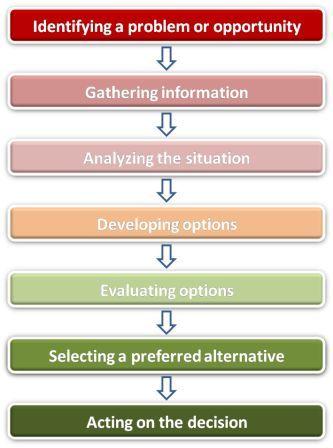
1: Identifying a problem or opportunity
The first step is to recognise a problem or to see opportunities that may be worthwhile. A rational decision making model is best employed where relatively complex decisions have to be made.
(So the first decision making lesson should be to ask yourself if you really have a problem to solve or a decision to make. Then read this article for more specific advice: Problem Solving Skill: Finding the Right Problem to Solve ).
2: Gathering information
What is relevant and what is not relevant to the decision? What do you need to know before you can make a decision, or that will help you make the right one?
3: Analyzing the situation
What alternative courses of action may be available to you? What different interpretations of the data may be possible? Our Problem Solving Activity uses a set of structured questions to encourage both broad and deep analysis of your situation or problem.
4: Developing options
Generate several possible options. Be creative and positive. Read The Power of Positive Thinking for our five questions that create possibilities.
5: Evaluating alternatives
What criteria should you use to evaluate? Evaluate for feasibility, acceptability and desirability. Which alternative will best achieve your objectives?
6: Selecting a preferred alternative
Explore the provisional preferred alternative for future possible adverse consequences. What problems might it create? What are the risks of making this decision?
7: Acting on the decision
Put a plan in place to implement the decision. Have you allocated resources to implement? Is the decision accepted and supported by colleagues? Are they committed to to making the decision work?
Strengths and Weaknesses of the Rational Decision Making Model

However, we should always remember that whilst the model indicates what needs to be done, it’s often how things are done that characterises effective decision making.
Paul C. Nutt’s research illustrates that bad decisions were usually bad because two things were missing:
- Adequate participation of stakeholders in the decision making process
- Sufficient time spent generating a range of possible solutions
Too often those who should have been involved weren’t, and solutions were proposed and acted upon too quickly. Often with disastrous effects!
A second weakness arises if we attempt to use the model in isolation. This is particularly important where complex or important decisions are involved.
The principle assumption of the rational decision making process is that human beings make rational decisions. However, there are numerous factors which determine our decisions, many of which are not rational. In many situations decisions have to be made with incomplete and insufficient information.
Putting the Rational Decision Making Model to work
Regardless of any perceived weaknesses these models are essential tools.

You’ll find more on these and other practical techniques in our related e-guides (below) or in Making Better Decisions.
Use the tools in this guide to help your decision making:
Tool 1: Do you need to make a decision? Tool 2: The POCA decision making model Tool 3: Decision levels Tool 4: 7 step decision making process Tool 5: Team decision making Tool 6: Evaluating alternatives
See for yourself that a rational decision making model can help us to make better decisions – and thus help us to be better managers.
Further Reading
Definition of decision making Intuition and decision making
>>> Return to the Decision Making Knowledge Hub
Looking for more decision making resources.
Try our great value e-guides
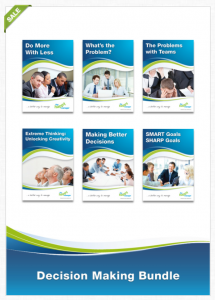
Decision Making Bundle
Making better decisions.

Managing Performance Bundle
These are fantastic little e-books, very thorough, easy to follow.
We’ve used [ the guides ] as support tools for learners on our talent management programmes which has saved me a lot of time and a lot of money. I’d definitely recommend them.
Kieleigh - United Kingdom

Grab a Freebie
Sign up to our newsletter and receive "How to be a Happy Manager"

Grab a Freebie!
Sign up to our newsletter and receive a free copy of "How to be a Happy Manager"
- Email This field is for validation purposes and should be left unchanged.
The Happy Manager
- Testimonials
- Write For Us
- Terms & Conditions
Knowledge Hub
What's new.
- Why Your Business Location Has an Impact on Your Employees’ Happiness
- How Outplacement Services Can Benefit Your Employees and Your Business
- 5 Tips for Boosting Team Productivity
- Employee Happiness and Social Media: A Strategy for Business Success?
- Best Practices for Managing Large Engineering Projects
- Can Applicant Tracking Systems Improve the Selection Process?
© 2024 The Happy Manager. Part of Apex Leadership Ltd. Tel +44 (0)7572 797430
- Privacy Policy
Website by Limely
Click on the links to download your free tools
- Phone This field is for validation purposes and should be left unchanged.
This website uses cookies to ensure you get the best experience on our website. Learn More
- Share full article
For more audio journalism and storytelling, download New York Times Audio , a new iOS app available for news subscribers.

- May 15, 2024 • 25:48 The Possible Collapse of the U.S. Home Insurance System
- May 14, 2024 • 35:20 Voters Want Change. In Our Poll, They See It in Trump.
- May 13, 2024 • 27:46 How Biden Adopted Trump’s Trade War With China
- May 10, 2024 • 27:42 Stormy Daniels Takes the Stand
- May 9, 2024 • 34:42 One Strongman, One Billion Voters, and the Future of India
- May 8, 2024 • 28:28 A Plan to Remake the Middle East
- May 7, 2024 • 27:43 How Changing Ocean Temperatures Could Upend Life on Earth
- May 6, 2024 • 29:23 R.F.K. Jr.’s Battle to Get on the Ballot
- May 3, 2024 • 25:33 The Protesters and the President
- May 2, 2024 • 29:13 Biden Loosens Up on Weed
- May 1, 2024 • 35:16 The New Abortion Fight Before the Supreme Court
- April 30, 2024 • 27:40 The Secret Push That Could Ban TikTok
The Possible Collapse of the U.S. Home Insurance System
A times investigation found climate change may now be a concern for every homeowner in the country..
Hosted by Sabrina Tavernise
Featuring Christopher Flavelle
Produced by Nina Feldman , Shannon M. Lin and Jessica Cheung
Edited by MJ Davis Lin
With Michael Benoist
Original music by Dan Powell , Marion Lozano and Rowan Niemisto
Engineered by Alyssa Moxley
Listen and follow The Daily Apple Podcasts | Spotify | Amazon Music | YouTube
Across the United States, more frequent extreme weather is starting to cause the home insurance market to buckle, even for those who have paid their premiums dutifully year after year.
Christopher Flavelle, a climate reporter, discusses a Times investigation into one of the most consequential effects of the changes.
On today’s episode

Christopher Flavelle , a climate change reporter for The New York Times.

Background reading
As American insurers bleed cash from climate shocks , homeowners lose.
See how the home insurance crunch affects the market in each state .
Here are four takeaways from The Times’s investigation.
There are a lot of ways to listen to The Daily. Here’s how.
We aim to make transcripts available the next workday after an episode’s publication. You can find them at the top of the page.
Christopher Flavelle contributed reporting.
The Daily is made by Rachel Quester, Lynsea Garrison, Clare Toeniskoetter, Paige Cowett, Michael Simon Johnson, Brad Fisher, Chris Wood, Jessica Cheung, Stella Tan, Alexandra Leigh Young, Lisa Chow, Eric Krupke, Marc Georges, Luke Vander Ploeg, M.J. Davis Lin, Dan Powell, Sydney Harper, Mike Benoist, Liz O. Baylen, Asthaa Chaturvedi, Rachelle Bonja, Diana Nguyen, Marion Lozano, Corey Schreppel, Rob Szypko, Elisheba Ittoop, Mooj Zadie, Patricia Willens, Rowan Niemisto, Jody Becker, Rikki Novetsky, John Ketchum, Nina Feldman, Will Reid, Carlos Prieto, Ben Calhoun, Susan Lee, Lexie Diao, Mary Wilson, Alex Stern, Dan Farrell, Sophia Lanman, Shannon Lin, Diane Wong, Devon Taylor, Alyssa Moxley, Summer Thomad, Olivia Natt, Daniel Ramirez and Brendan Klinkenberg.
Our theme music is by Jim Brunberg and Ben Landsverk of Wonderly. Special thanks to Sam Dolnick, Paula Szuchman, Lisa Tobin, Larissa Anderson, Julia Simon, Sofia Milan, Mahima Chablani, Elizabeth Davis-Moorer, Jeffrey Miranda, Renan Borelli, Maddy Masiello, Isabella Anderson and Nina Lassam.
Christopher Flavelle is a Times reporter who writes about how the United States is trying to adapt to the effects of climate change. More about Christopher Flavelle
Advertisement
We've detected unusual activity from your computer network
To continue, please click the box below to let us know you're not a robot.
Why did this happen?
Please make sure your browser supports JavaScript and cookies and that you are not blocking them from loading. For more information you can review our Terms of Service and Cookie Policy .
For inquiries related to this message please contact our support team and provide the reference ID below.

IMAGES
VIDEO
COMMENTS
The rational planning model is a model of the planning process involving a number of rational actions or steps. Taylor (1998) outlines five steps, ... It is likely that growth in the volume of the business will engender both economies of scale and innovation that will reduce costs substantially. Requirements and limitations
The rational planning model is central in the development of transport planning & modern planning. Similarly, rational decision-making model is a process of making decisions which are logically sound. This multi-step model and aims to be logical and follow the orderly path from problem identification through solution. Rational Planning Model.
If you wish to use the rational model to make a decision, it's important to first understand how the model works. There are five straightforward steps that you can follow to apply the rational decision-making model to any given situation. The steps include: 1. Identify a challenge or opportunity. When making a rational decision, it's important ...
Conceptual models and processes: Advocacy, equity, rational, strategic, communicative, collaborative, radical, and so on, along with planning processes. ... Davidoff (Citation 1965) proposed the advocacy planning model. More recently Avin and Goodspeed (Citation 2020) reviewed the fast-growing area of exploratory scenario planning using case ...
In addition to the rational decision making, bounded rationality, and intuitive decision-making models, creative decision making is a vital part of being an effective decision maker. Creativity is the generation of new, imaginative ideas. With the flattening of organizations and intense competition among companies, individuals and organizations ...
Making strategic, tactical, and operational decisions is an integral part of the planning function in the P-O-L-C (planning-organizing-leading-controlling) model. However, decisions that are unique and important require conscious thinking, information gathering, and careful consideration of alternatives. These are called nonprogrammed decisions.
Definition. Being the opposite of intuitive decision making, rational model of decision making is a model where individuals use facts and information, analysis, and a step-by-step procedure to come to a decision. The rational model of decision making is a more advanced type of decision-making model.
The rational decision-making process typically involves several vital steps. 1. Defining the problem: First, Lauren needs to clearly define the issue, which is the decision between spending on office space for her growing clientele vs. Buying a luxurious car. 2.
The Rational Decision-Making Model. The Rational Decision-Making Model is a method of taking emotion out of making decisions and applying logical steps to work towards a solution. The model ...
One of the traditional planning processes is the rational planning model (RPM). The rational planning model follows a multi-stage process that leads to better decision making for planning. ... business representatives, developers, community groups, residents, etc.) to set development goals and policies (e.g., what are we trying to achieve and ...
Here are five steps you can follow to apply the rational model of decision making: 1. Identify a challenge or opportunity. To make a rational decision, first identify the situation and determine whether it's a challenge or an opportunity. For example, a challenge might be that you want to reduce the amount of material waste a process creates ...
Classic types of strategic planning. Three classical strategic planning models are rational, incremental, and organic. 1. The rational model of strategic planning. The rational model is a top-down, step-by-step process in which a company analyzes its industry, competitors, and environment to identify opportunities and threats.
Strategy as design. This is the view that strategy formulation is a rational, logical process where information is carefully considered and predictions made. Strategic choices are made and implementation takes place. Essentially this is the same as the rational planning model discussed earlier. Strategy as experience.
Rational decision-making is a method that organizations, businesses and individuals use to make the best decisions. Rational decision-making, one of many decision-making tools, helps users come up with the most suitable course of action. In this blog, we will look at the meaning of rational decision-making, the importance of rational decision ...
Rational Decision Making Model: 7 Easy Steps (+ Examples) 1. Verify and define your problem. To prove that you actually have a problem, you need evidence for it. Most marketers think data is the silver bullet that can diagnose any issue in our strategy, but you actually need to extract insights from your data to prove anything.
1. Basic model. The basic strategic planning model is ideal for establishing your company's vision, mission, business objectives, and values. This model helps you outline the specific steps you need to take to reach your goals, monitor progress to keep everyone on target, and address issues as they arise.
The comprehensive decision-making process is often referred to as the rational-comprehensive decision-making process, because of the emphasis on a cost-benefit analysis of the information gathered. It is very similar to rational choice decision-making. The cost-benefit analysis requires that the strengths and weaknesses of each possible ...
Definition. Being the opposite of intuitive decision making, rational model of decision making is a model. where individuals use facts and information, anal-. ysis, and a step-by-step procedure to ...
The Business Motivation Model was originally developed by the Business Rules Group, a non-commercial consulting firm, in the late 1990s. Its goal was to help people prepare business plans in an ordered, efficient, properly-organized way. Put simply, the Business Motivation Model helps you think about why you're creating a business plan ...
Steps Involved in Rational Decision-Making. The rational decision-making process comprises several key steps. Here's a rundown: 1. Identify the Decision. The first step in rational decision-making is acknowledging that a decision is required. The decision is usually a problem but can also be an opportunity.
A rational decision making model provides a structured and sequenced approach to decision making. Using such an approach can help to ensure discipline and consistency is built into your decision making process. As the word rational suggests, this approach brings logic and order to decision making. Our rational decision making model consists of ...
the rational model in business curriculum revision and development efforts. And, perhaps most importantly, is that rationality proposes a method for the maximization of benefits from analytical decision-making against the minimization of inherent costs from surface or underlying factors in
This is the view that strategy formulation is a rational, logical process where information is carefully considered and predictions made. Strategic choices are made and implementation takes place. Essentially this is the same as the rational planning model discussed earlier. Strategy as experience. This is the view that future strategies are ...
Christopher Flavelle contributed reporting.. The Daily is made by Rachel Quester, Lynsea Garrison, Clare Toeniskoetter, Paige Cowett, Michael Simon Johnson, Brad ...
Ramos: The second-most common is the customization of generative AI models with things like prompt engineering. That includes things like retrieval-augmented generation [RAG]. The third is fine-tuning or re-training models. The difference between that and customization is that organizations are changing existing models.
Number of RL agents ( ) Figure 2: Different emerging strategies for different economic environments.The middle panel (B) shows the time series of observed sales (Ys) and price-deltas (∆˜P) for a sample bounded rational agent (dashed line) and RL agent (solid line) under 3 different combinations of market competition (z c) and degree of rationality (N) as indicated by the arrows.
Connecting decision makers to a dynamic network of information, people and ideas, Bloomberg quickly and accurately delivers business and financial information, news and insight around the world